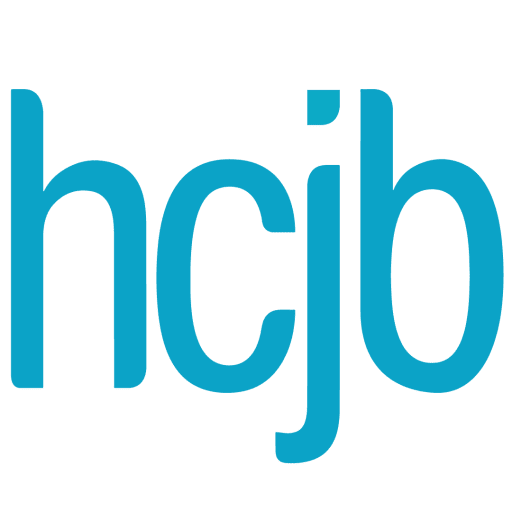OUR STORY
90 years which started with a decision…
What were the beginnings of HCJB? How has Ecuador and the world been impacted beyond its work in radio? Learn how through this multimedia timeline, where you can read and listen to the stories that shaped the beginnings of the Voice of the Andes.
-
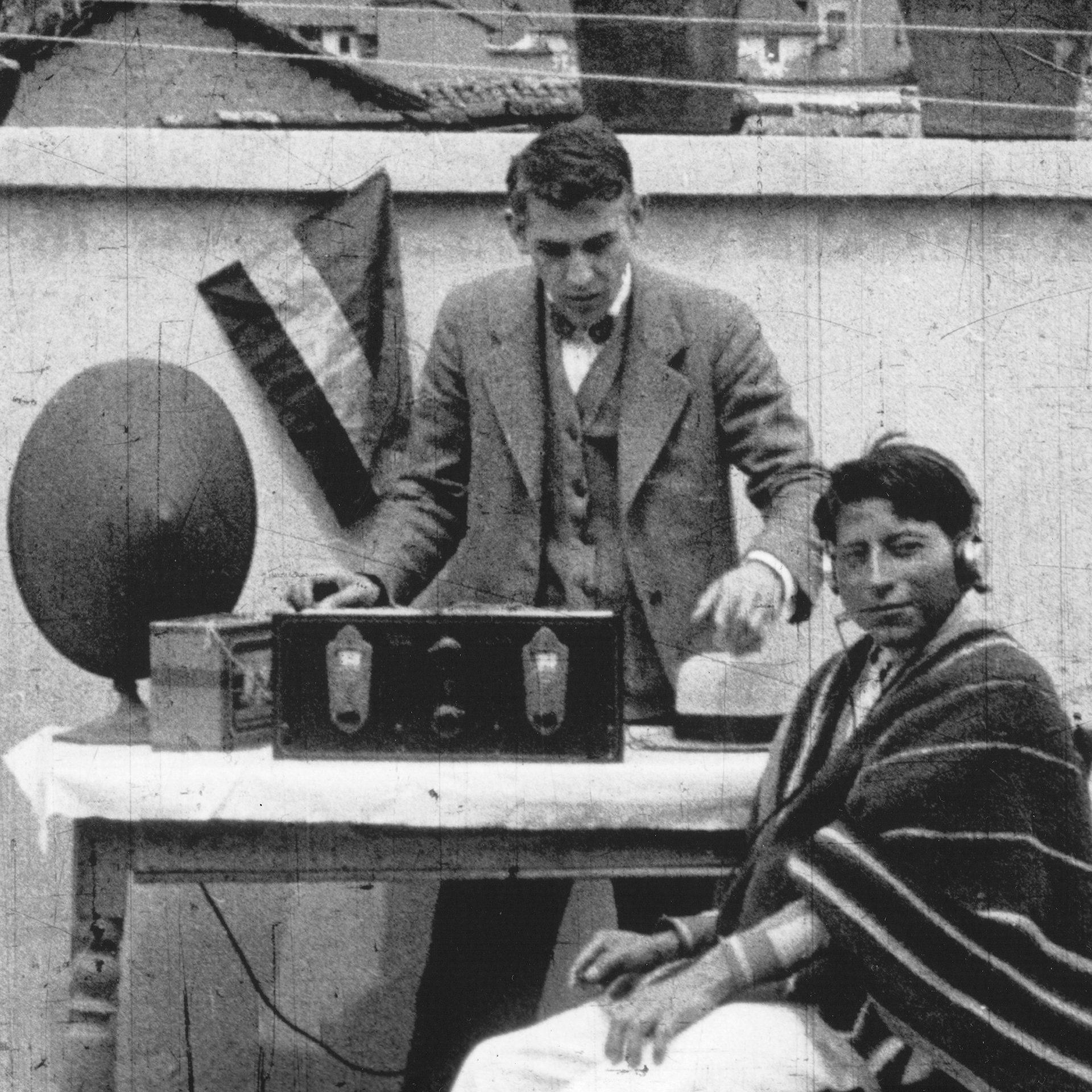
The Beginning of Radio in Ecuador
Radio was virtually non-existent in Ecuador in 1930. As far as it could be determined, there were only six radio receivers in the entire country. So Clarence Jones arranged for Reed & Reed to import and distribute radios. He also sold radios personally through his Quito Radio Agency.
But HCJB was not the first to broadcast via radio in Ecuador. In 1925, Carlos Cordovéz, an electrical engineer and inventor, made the very first experimental radio broadcast in Ecuador. From his amateur station “ el Prado” in Riobamba, Cordovéz made a two-hour broadcast each Thursday night from 1929 until 1939 -
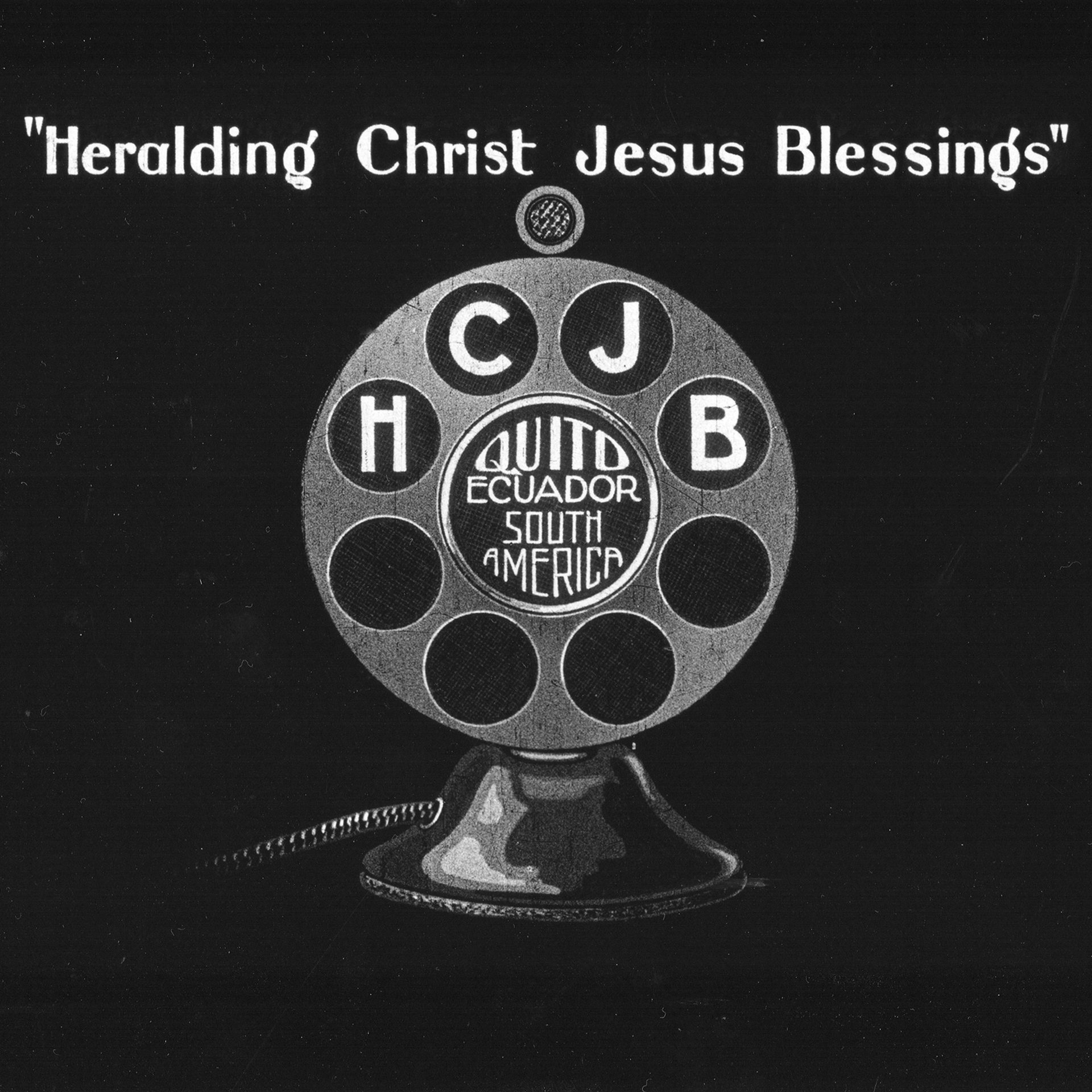
HCJB on the «Silver Screen»
Clarence Jones visited Ecuador in October 1930. He used a borrowed movie camera to make what was perhaps the world’s very first missionary film.
The movie introduced the people and country of Ecuador to audiences across the United States. The film also introduced to many the letters HCJB – Heralding Christ Jesus’ Blessings. -
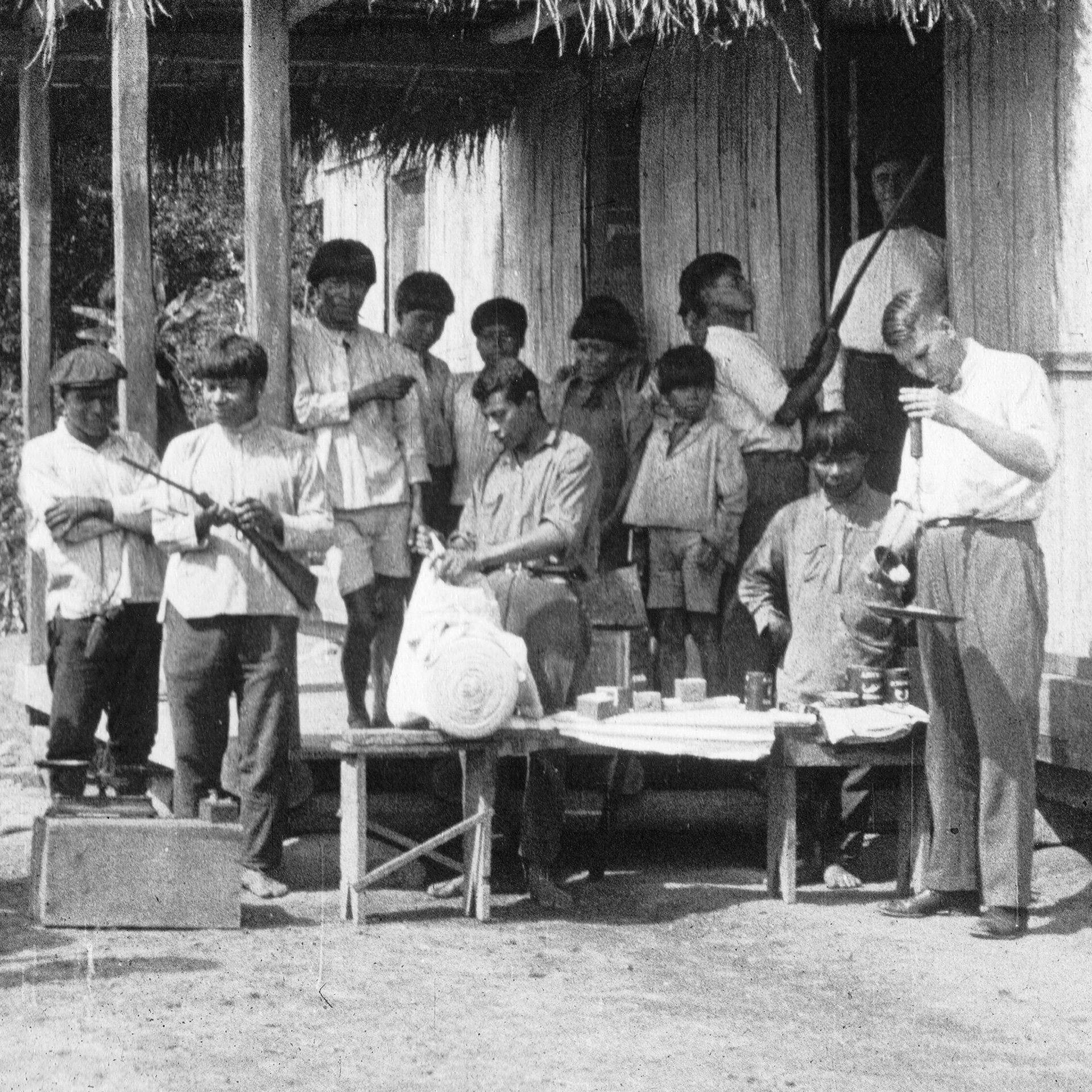
How do you share the gospel with people scattered throughout the jungle?
This was not an easy task for Reuben and Grace Larson; the local Quichua Indians ran away and hid from them! Reuben decided that building a trading post at Dos Rios could bring people right to his doorstep. At first, they traded matches, machetes and various trinkets for food for their family. As the Larsons reputation for honesty grew, they distributed salt, delivered mail and bought gold for the Ecuadorian government. Reuben also oversaw the maintenance of local schools and trails in the area.
-
Can you think of a better place?
Radio station HCJB had a rather humble beginning. Money was scarce and Clarence had to be resourceful. He needed to find a suitable place for the transmitter and for a workshop.
On the Quinta Corston property was an old sheep shed that was essentially just two mud walls and a roof. Jones and a helper closed in the open sides, added windows, poured a concrete floor and whitewashed the whole building. -

For One Sucre…
The station needed towers to support the radio antenna. But how could Clarence Jones and Eric Williams build them? The solution was to ask the Quito Electric company for their two tallest poles. The 85 ft. eucalyptus poles soon arrived at Quinta Corston. Two holes for the poles were dug 200 feet apart. They attached pulleys to the tops of the poles and quickly hoisted them up into place.
-
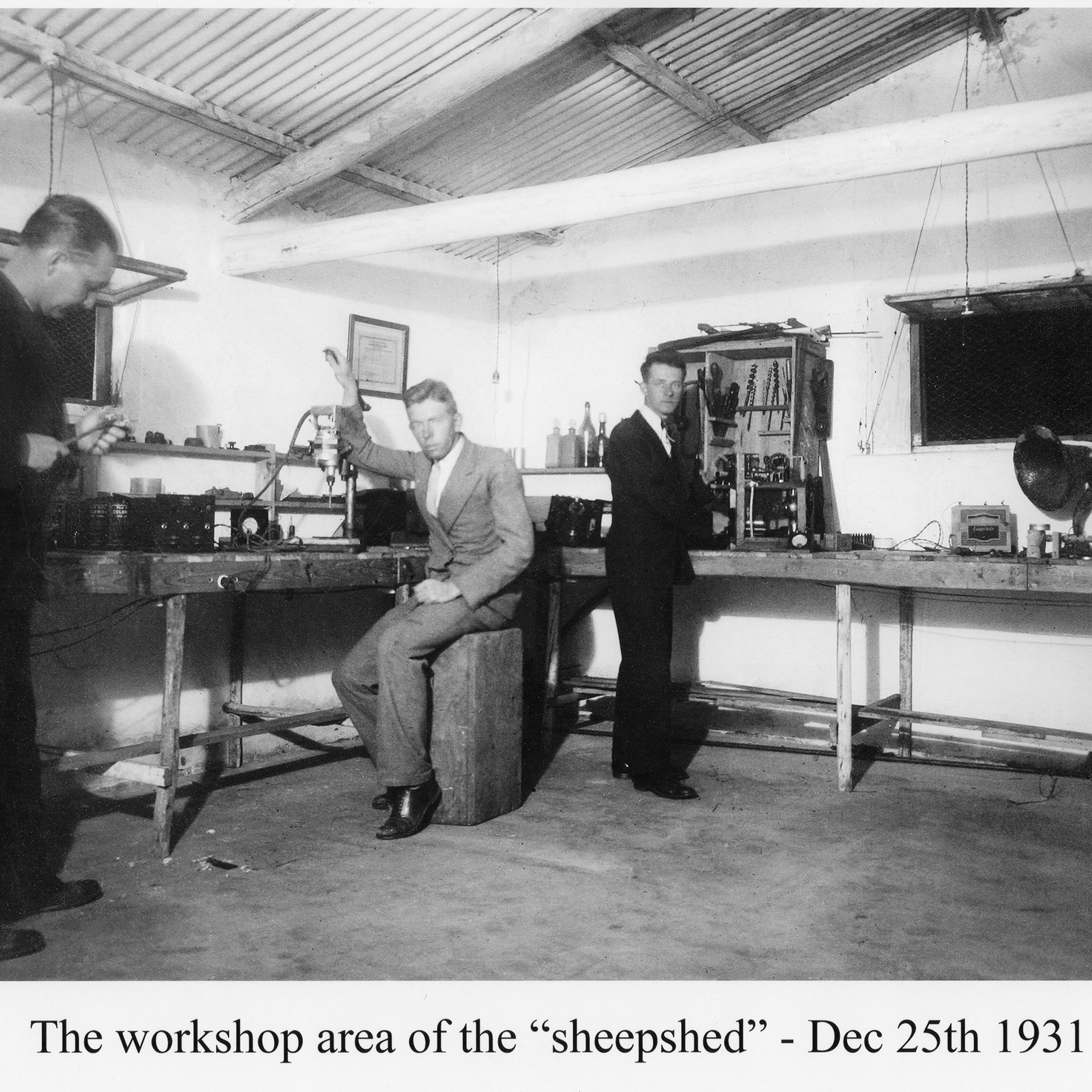
HCJB Engineers and Technicians
It was essential for Radio Station HCJB to have staff that could maintain and repair the radio transmitters. The lack of finances to purchase commercially built models meant that most all HCJB’s early radio transmitters were built by HCJB staff.
-
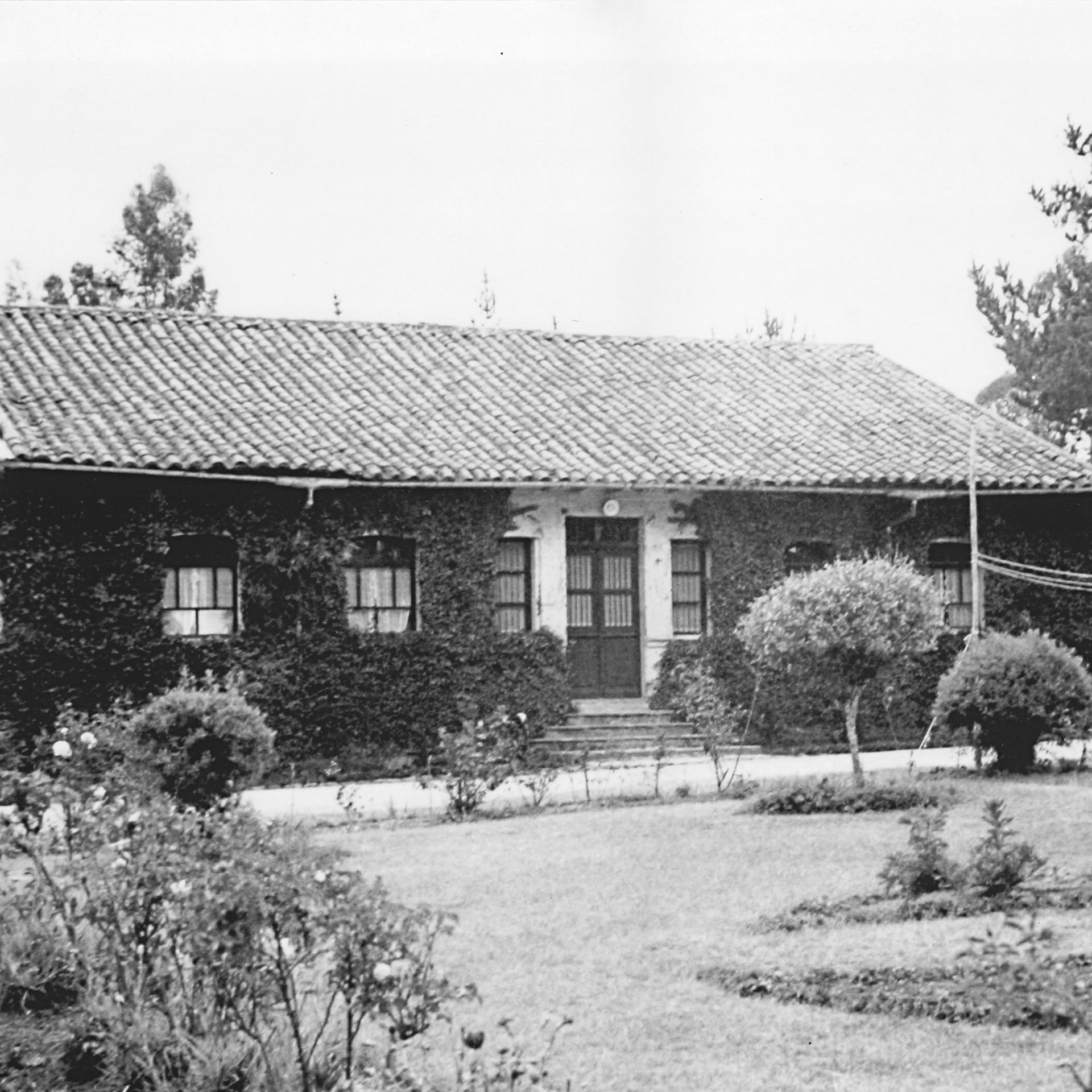
More than just a Home
On the Quinta Corston property was a charming ivy covered «cottage» built by the former Scottish owner. The Jones’ shared their home with Other staff and the house was frequently crowded with guests.
-
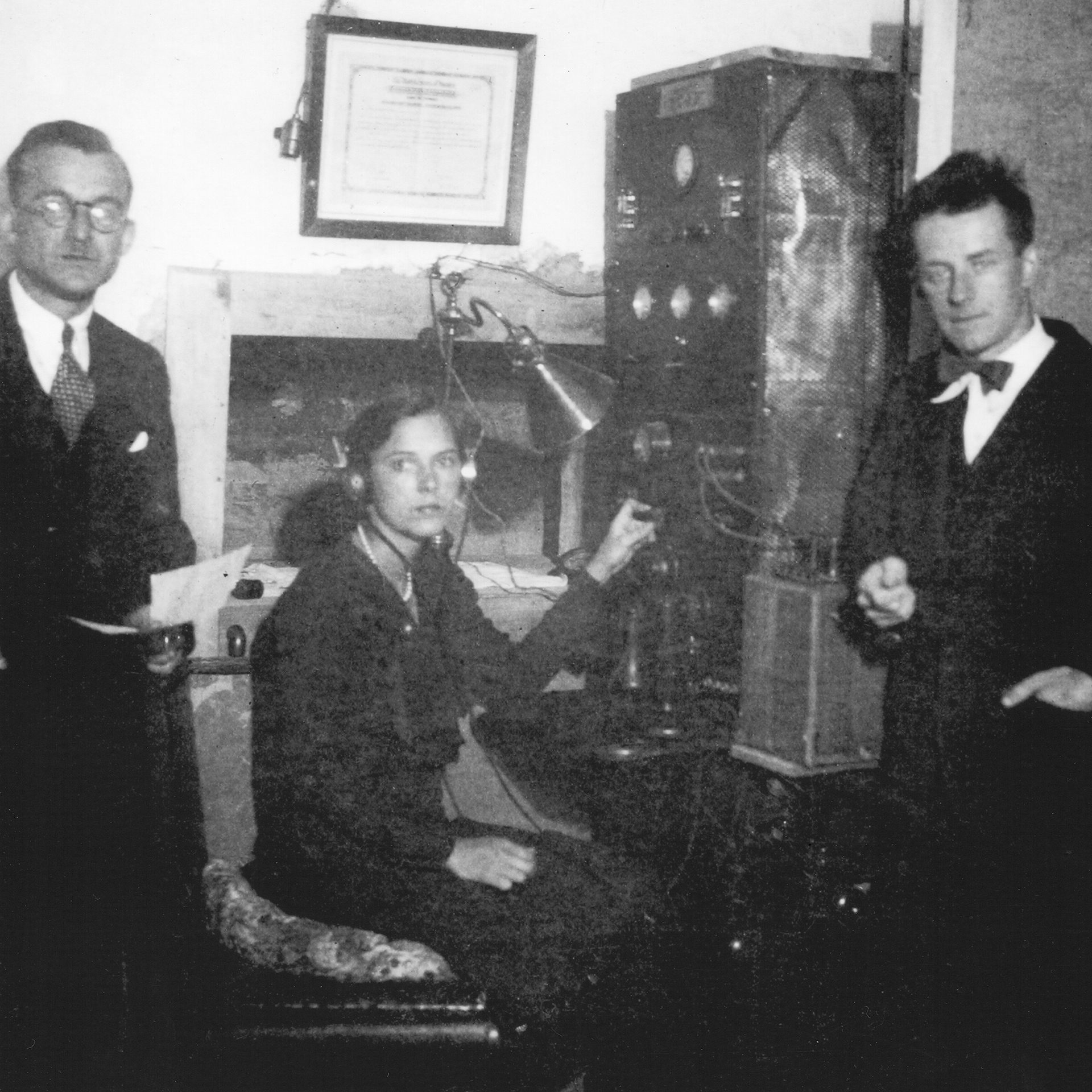
HCJB’s first broadcast almost didn’t happen…
Radio experts had told Clarence to stay away from the mountains and the equator. So Clarence decided to have Eric, a former CBS engineer build an experimental transmitter that would allow them to test different frequencies.
-
HCJB’s Vozandes Orchestra
When HCJB began in 1931 there were no tape recorders. Virtually all of the station’s programming was done live. Clarence contracted local classical musicians to form «la Orquestra Vozandes» (the Vozandes Orchestra).
-
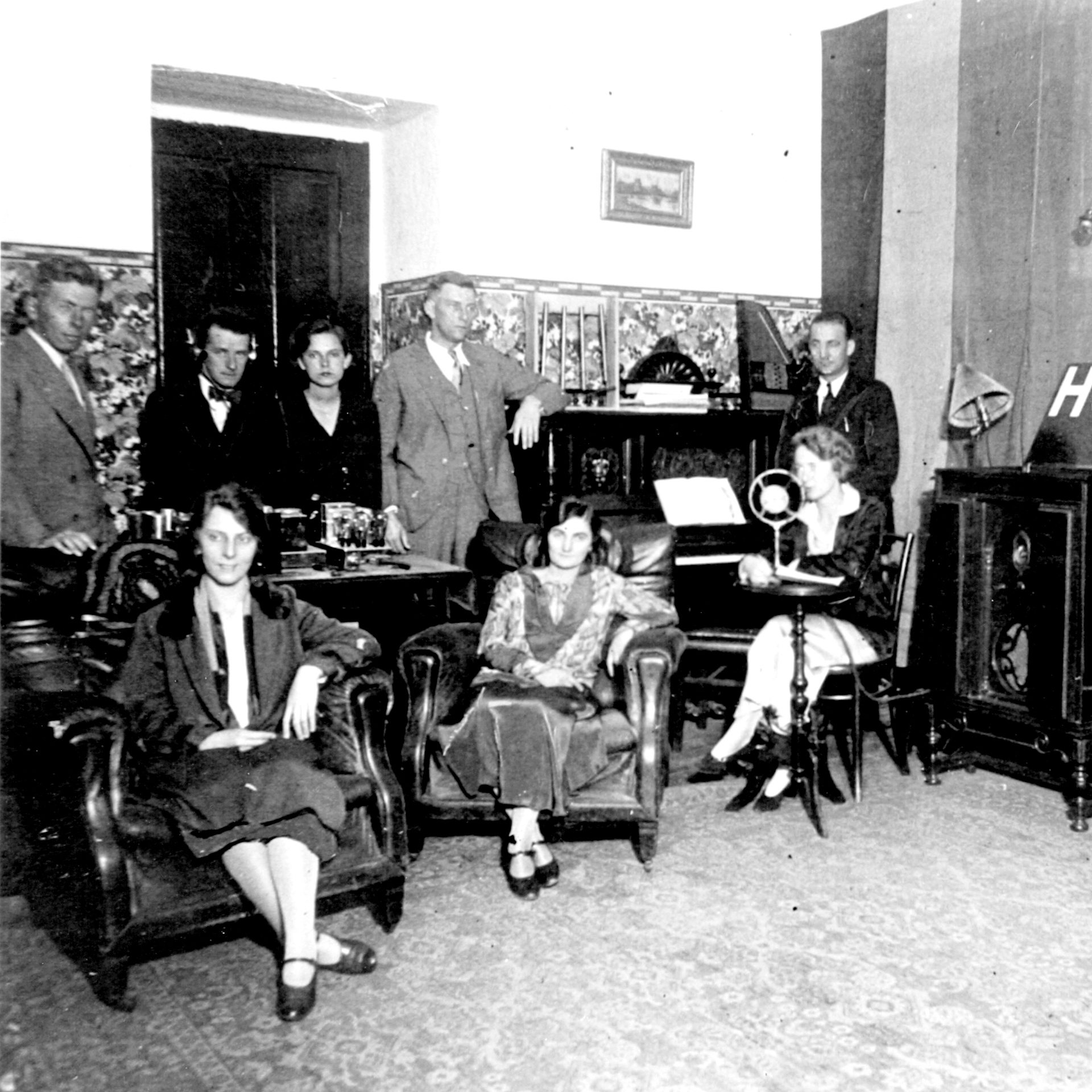
The First Program
In Quito all the missionary families came to «La Quinta Corston» to celebrate Christmas together.
-
Working Together
During the early years, Radio Station HCJB was largely operated by Ecuadorian staff. Missionaries from other organizations frequently helped in making radio programs. For a number of years however, Clarence and Katherine Jones were the only full-time missionaries at the station.
-
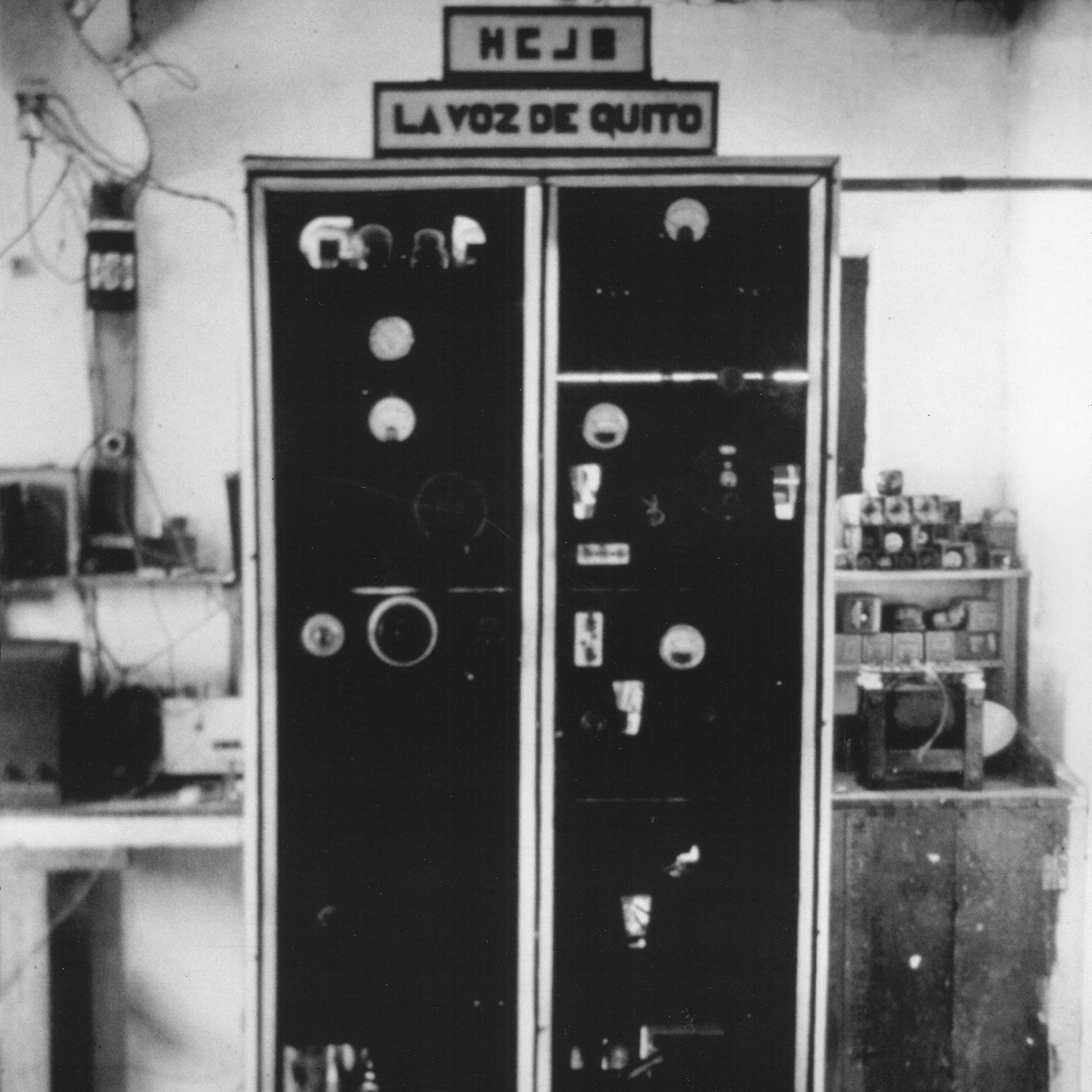
The Voice of Quito
Engineer Victoriano Salvador designed a 250-watt transmitter using parts of the original transmitter. However, as a devout Catholic, Victoriano refused to actually build it since HCJB was an evangelical radio station.
-

Away from Family
Clarence Jones came to Ecuador in October of 1931 with Eric and Ann Williams to set up radio station HCJB.
Clarence’s wife Katherine was due to give birth to their third child in December. So, Katherine and their two daughters remained in Chicago until the spring of 1932. -
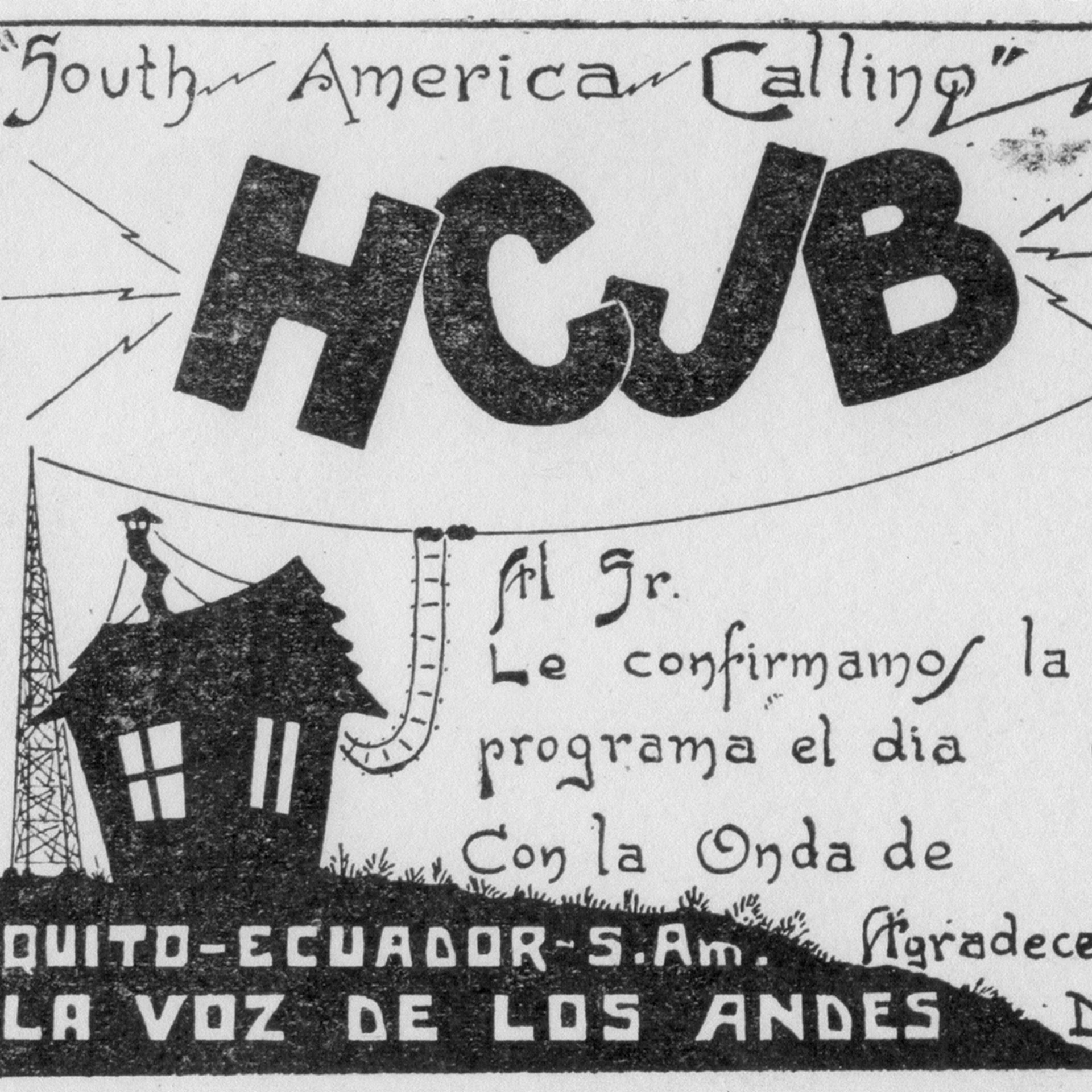
HCJB’s First QSL Card
The early years of radio history saw operators using only Morse code to “talk” with each other. Samuel Morse had originally devised the code of short and long taps in 1836 to send messages over wires using a telegraph. However, people later adopted a shorthand system of three letter codes, many beginning with the letter “Q”, to send common phrases.
-

Boxcar Evangelism
In 1933, HCJB was invited to join the «Silver Anniversary Exposition Train» commemorating the completion of «the world’s most difficult railroad.» For two months the train traveled from Quito to Guayaquil showcasing the industry, agriculture and commerce of Ecuador.
-
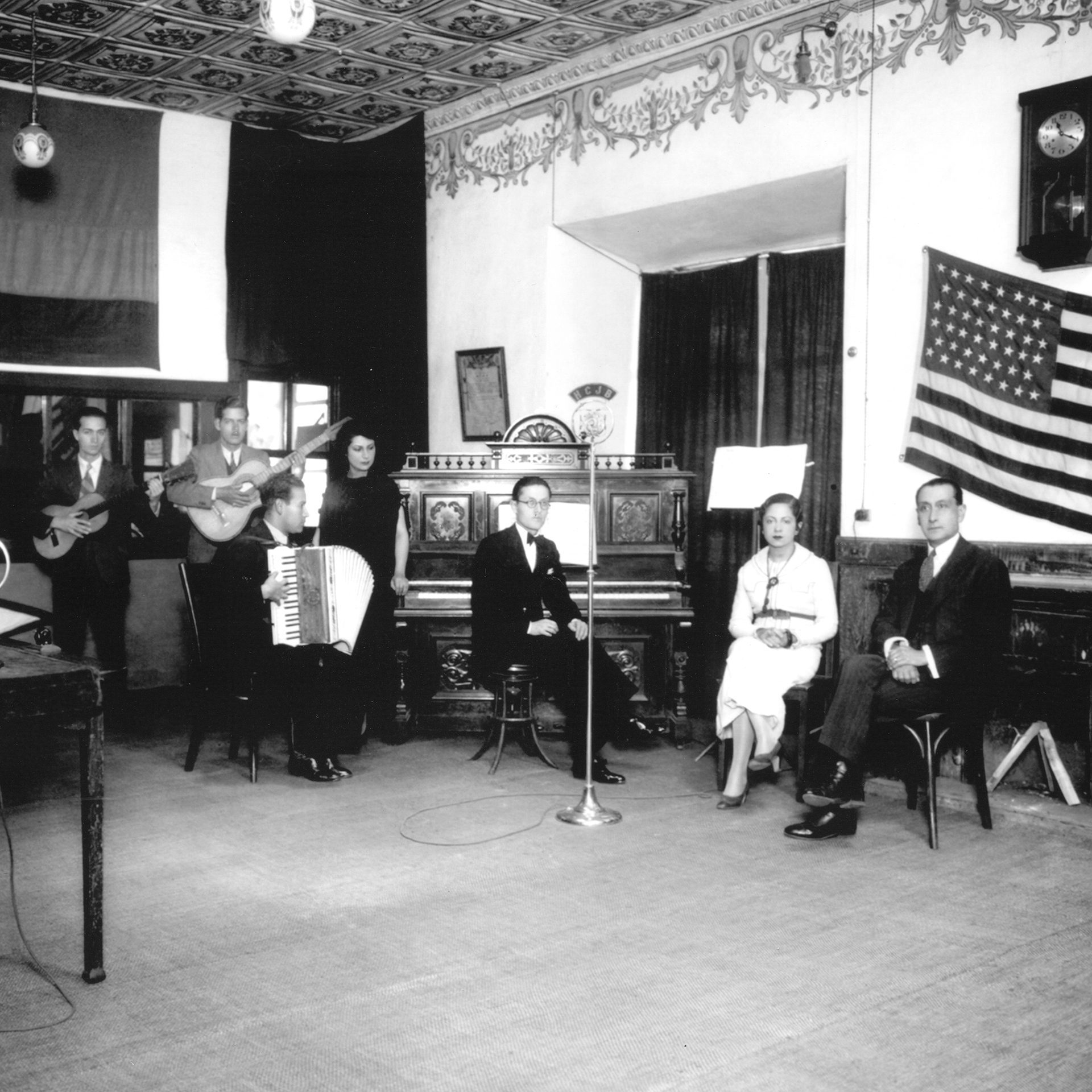
A Second Radio Studio
Radio Station HCJB’s Quinta Corston location on the northeast edge of Quito provided ample space for broadcasting when the station began in 1931. The station’s location was not very convenient for most people who were asked to take part in radio programs.
-
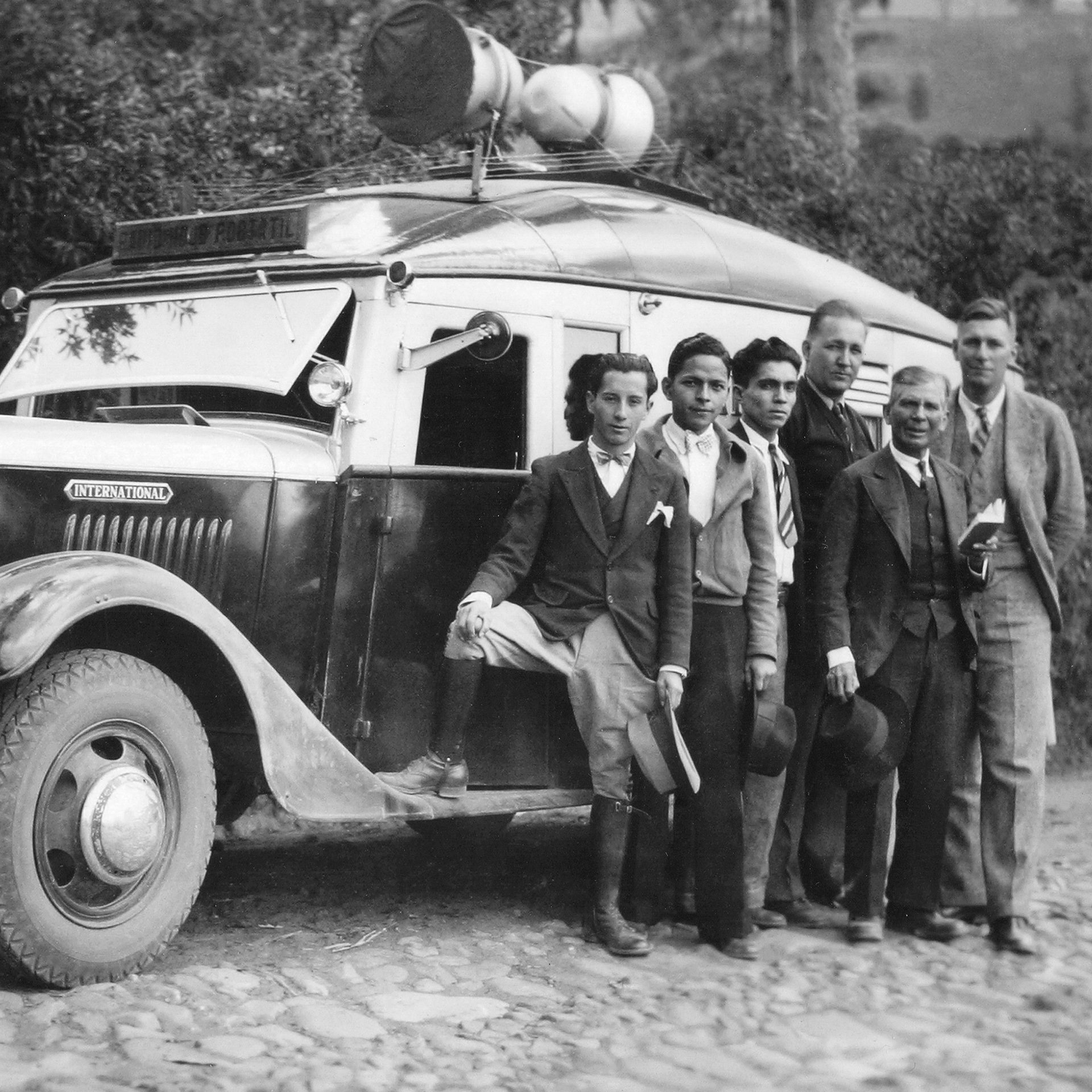
The Gospel Sound Truck
The success of using “radio” form a railroad boxcar to attract crowds inspired Clarence Jones and D.5. Clark to build the «Gospel Sound Truck.» A 1936 truck was outfitted with a portable transmitter, generator and loudspeakers to «broadcast» the gospel to all within range.
-
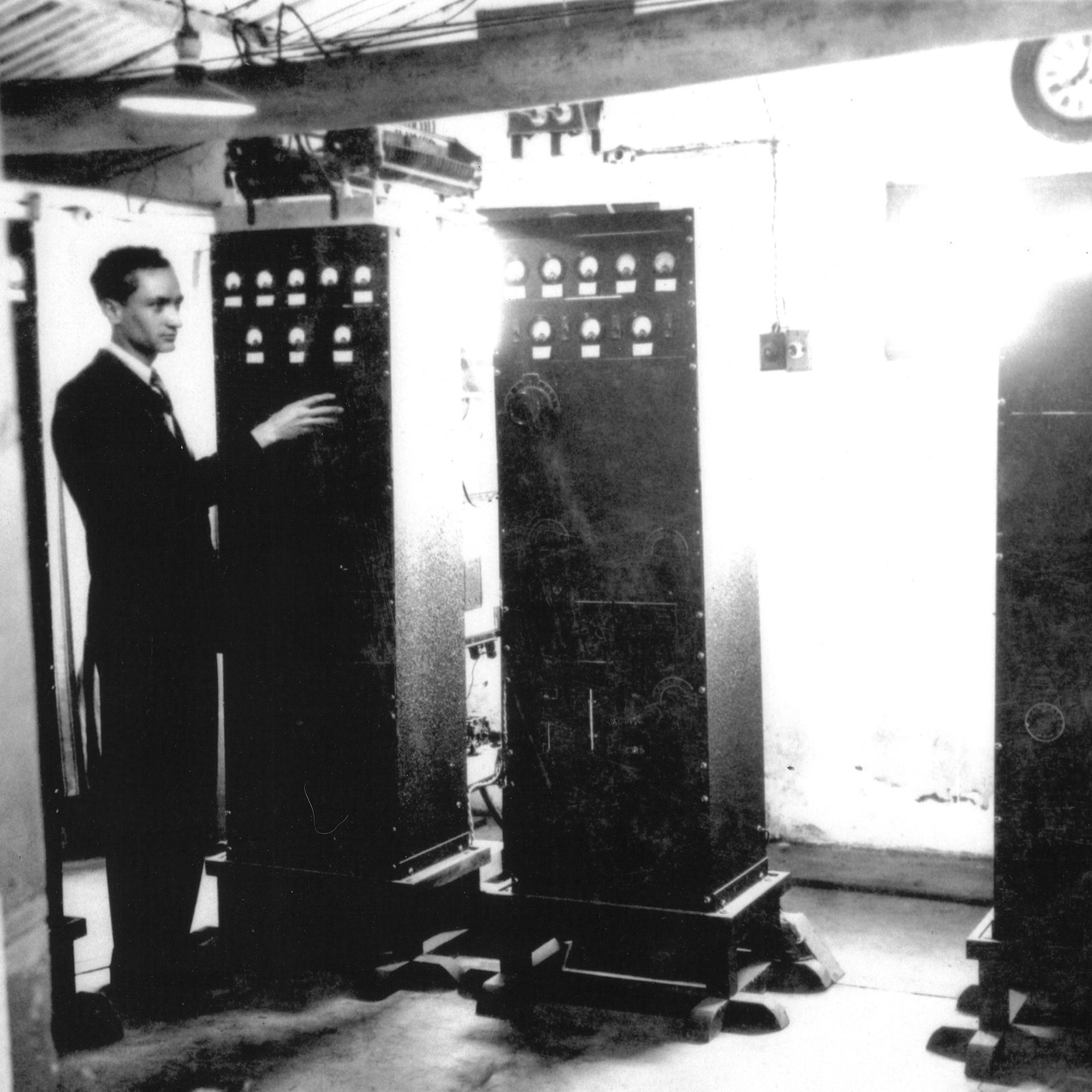
A Changed Heart
Engineer Victoriano Salvador joined HCJB’s technical staff not long after the station started. He designed several of HCJB’s early transmitters and built this 1,000-watt unit that went on air in 1937.
-

From Priest to Evangelist
As a child in Spain, Manuel Garrido Aldama was sent by his parents to be trained as a Roman Catholic priest.
-

Listen to HCJB!
A promotion in 1937 offered cash prizes of $25, $10 and $5. To win, people had to pick up a free weekly schedule at a Reed & Reed store and then listen to HCJB between 6 and 7 p.m. to hear the winning number.
-

Radio Station HCJB’s New Home
The city of Quito soon grew around HCJB’s original Quinta Corston property. Co-directors Clarence Jones and Reuben Larson realized that the station needed to be moved outside of the city limits to comply with the Ecuadorian broadcasting laws that Clarence had helped write.
-
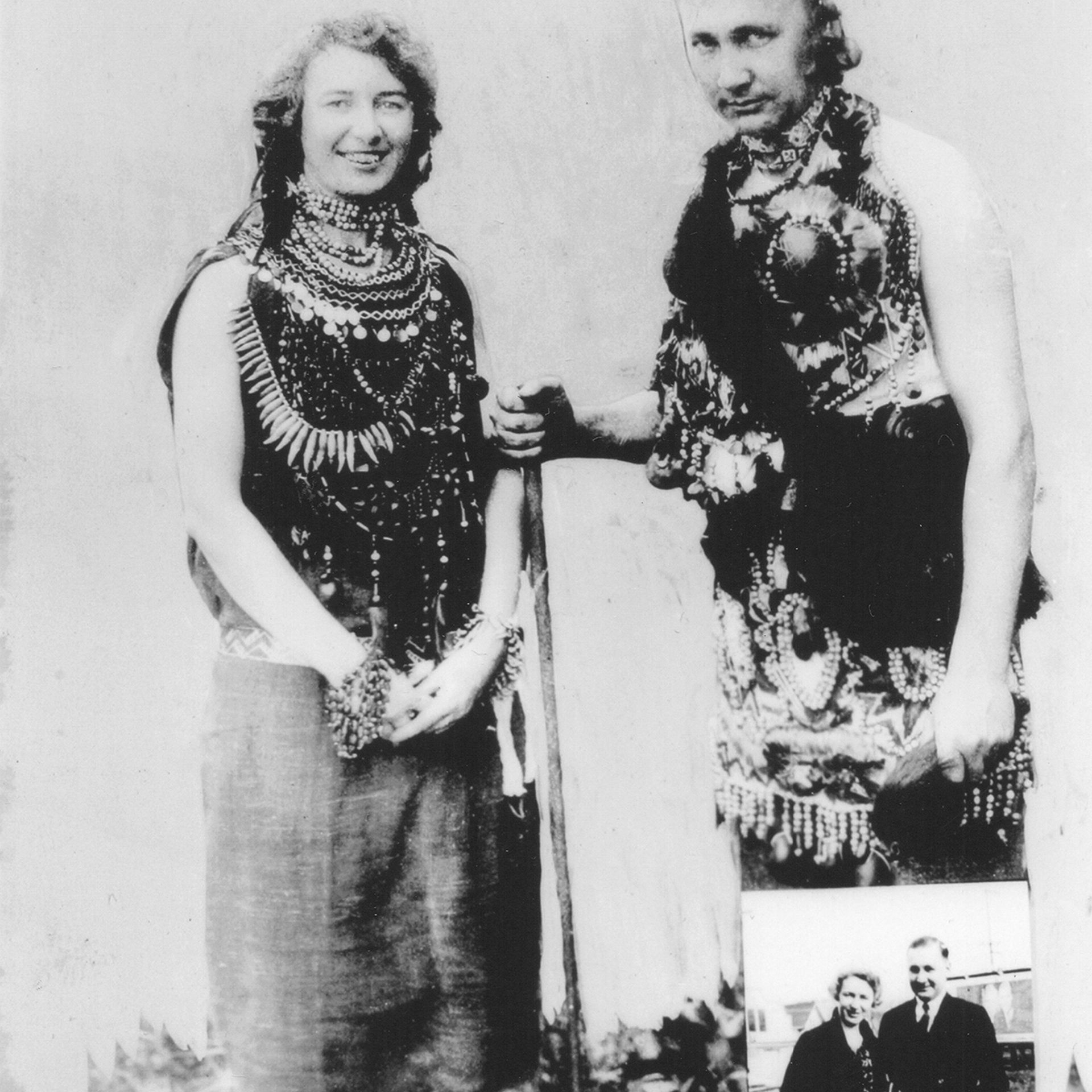
From Jungle Station to Radio Station
Reuben and Grace Larson were Christian & Missionary Alliance missionaries who began working in Ecuador in 1924. The Larson’s opened a mission station in the eastern jungle at Dos Rios (near Tena) where they started a church and a school for the jungle Quichuas.
-
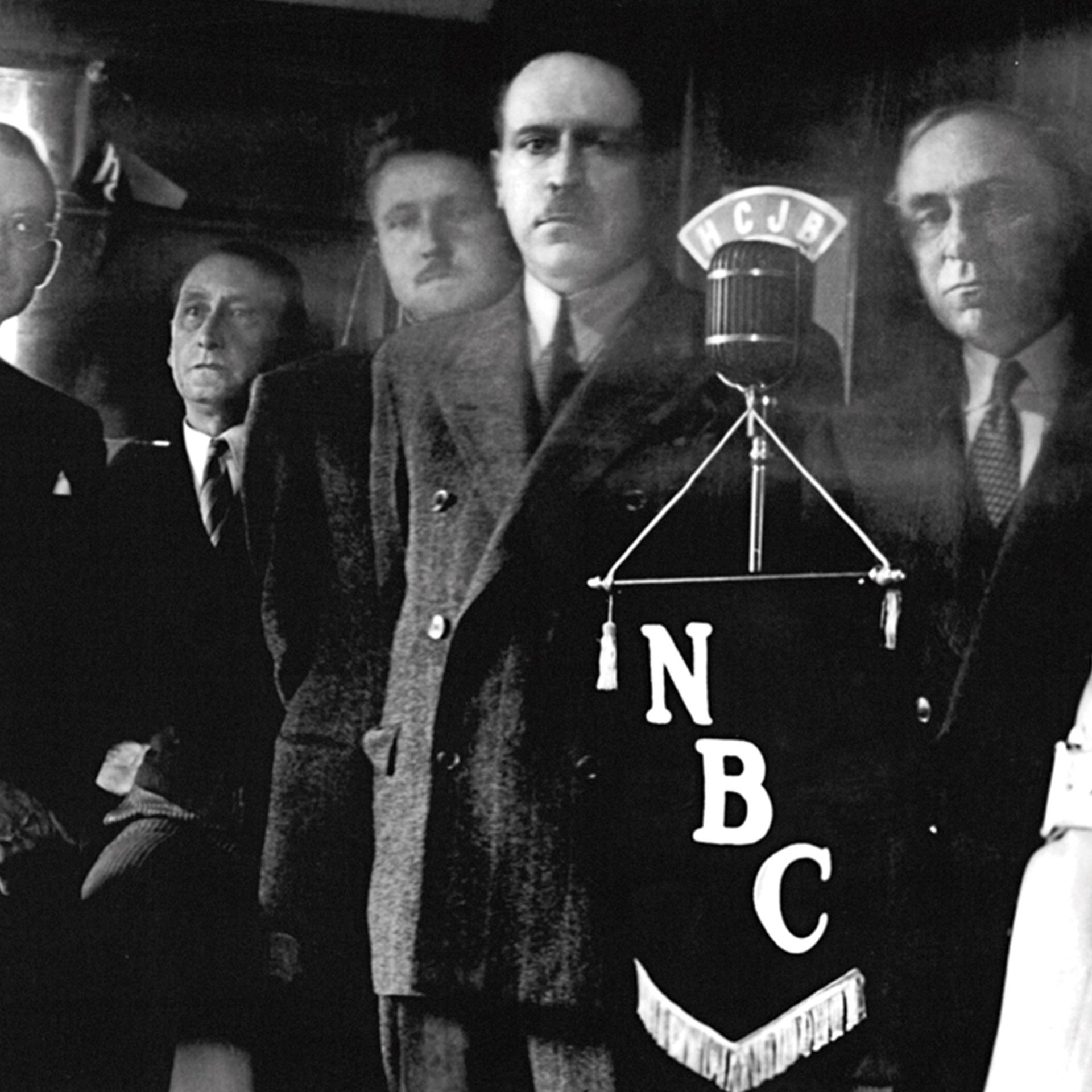
HCJB and NBC
With the outbreak of World War II in the early 1940s, HCJB became an affiliate of NBC (National Broadcasting Company). NBC was one of the largest media networks in the United States.
-
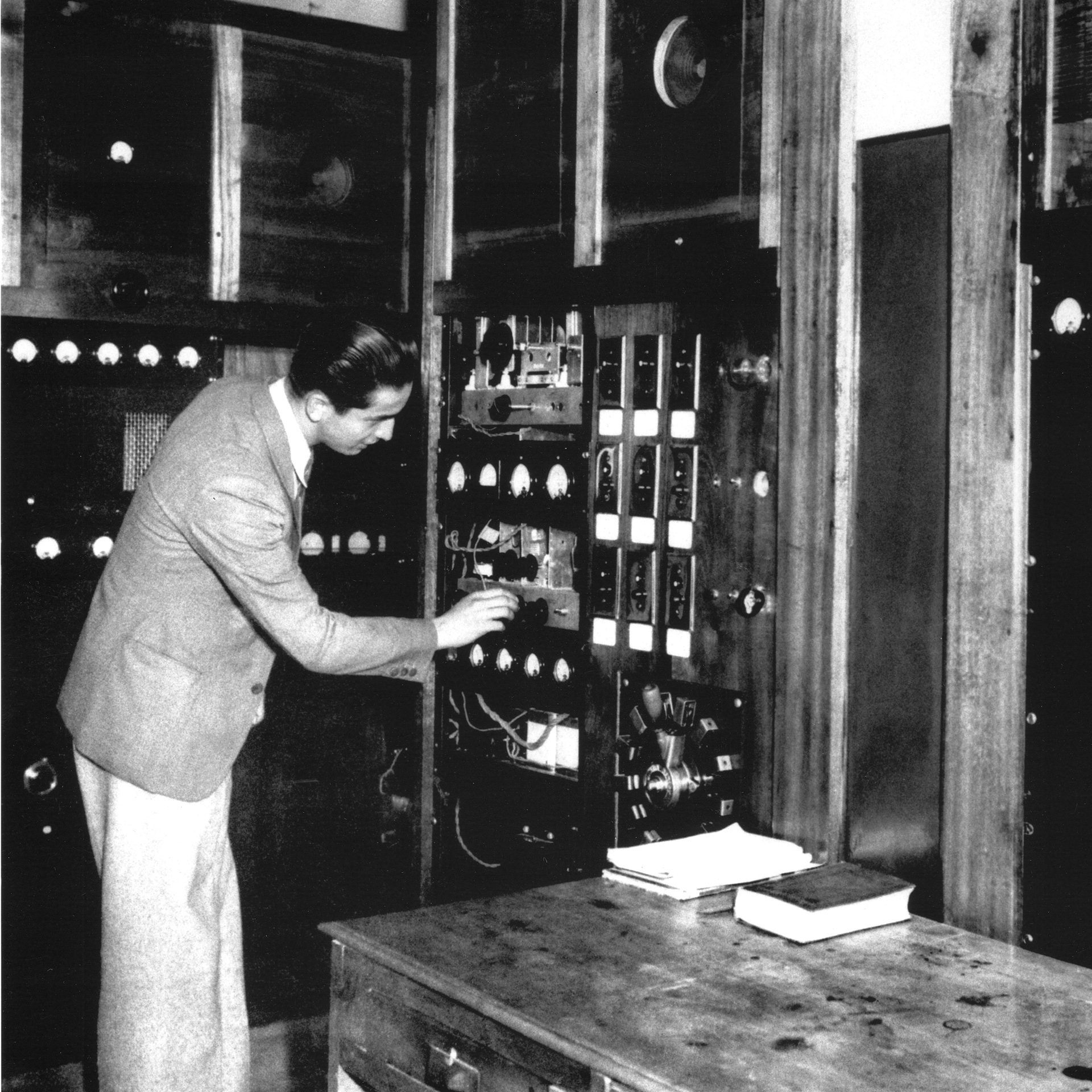
«It’s a Piece of Junk»
CIarence Moore was a pastor, teacher, and radio-enthusiast who felt God inexplicably leading him to drive from his home in Michigan to Chicago. After Moore arrived in Chicago, he went to his relative, Rev. John Meredith, and asked if perhaps he knew why God had brought him to Chicago. Rev. Meredith was a radio preacher whose programs aired on WMBI (Moody Bible Institute) and Radio Station HCJB.
-
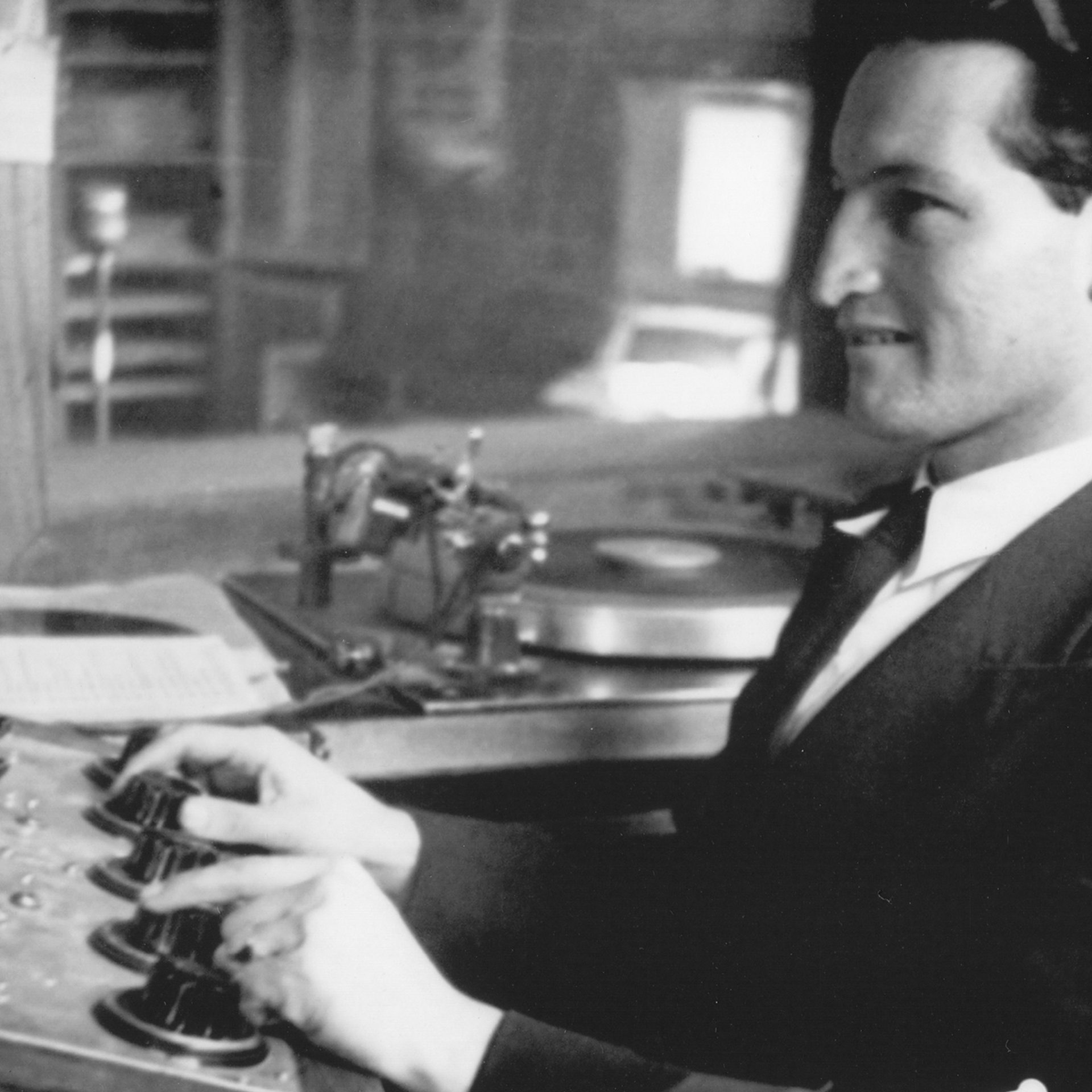
Steering Wheel to Microphone
In the early 1940s, public transportation from the city out to HCJB was infrequent. So HCJB chauffeur Enrique Romero drove employees to and from the station. Before long, Enrique began operating the controls during some radio programs. He also became an announcer on the radio.
-
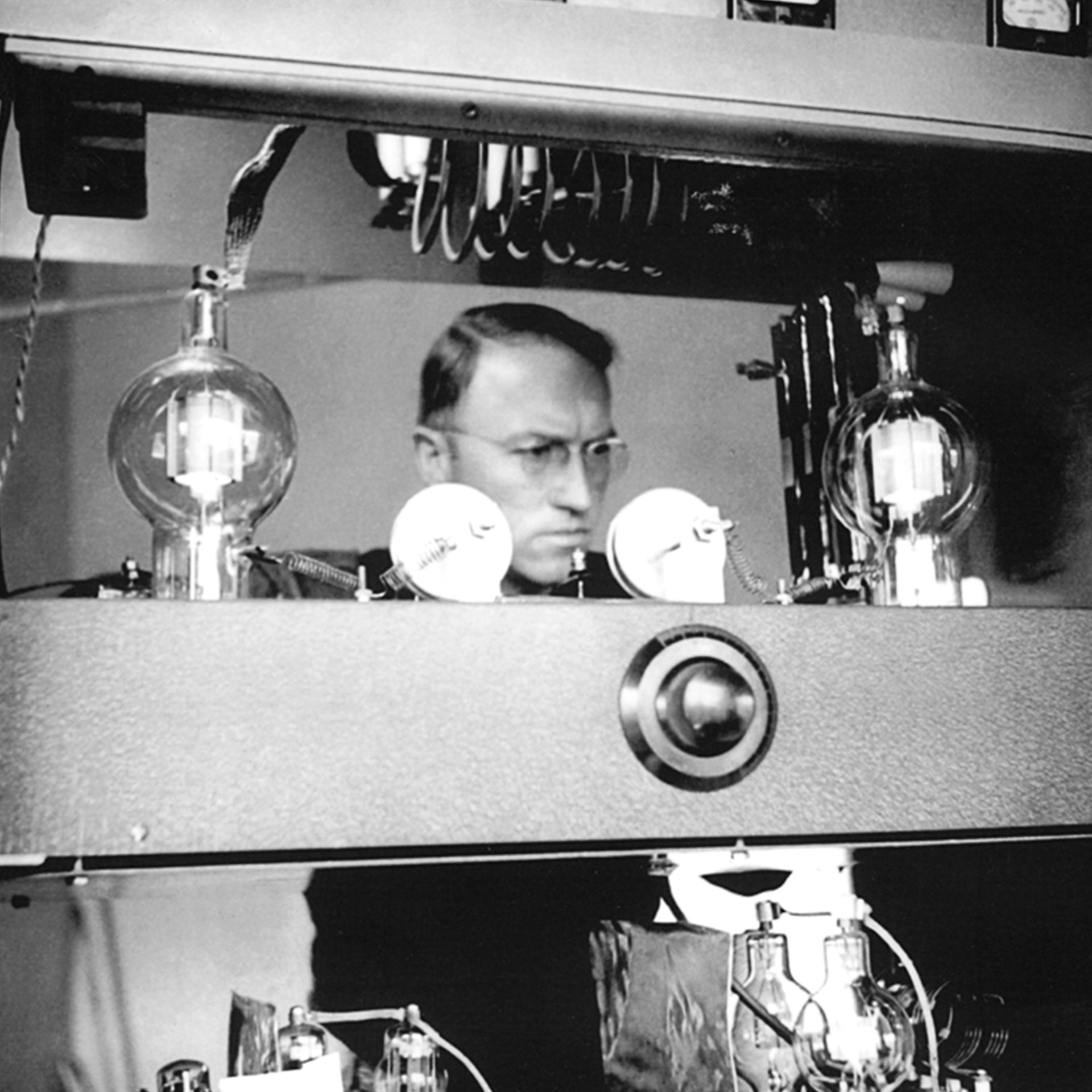
Just as Important
Having reliable technicians and operators was critical for HCJB. Staff had to carefully monitor and maintain equipment as well as manually switch between studios or transmitters at the precise time.
-

Decorated by the King
In 1941, Ellen de Campaña (at left) began making regular live Swedish broadcasts on HCJB. In 1952, King Gustaf VI Adolf of Sweden awarded Ellen a medal of the Vasa Order for her service to Swedish speaking people around the world. Ellen de Campaña was the first woman to be granted a medal of that order.
-
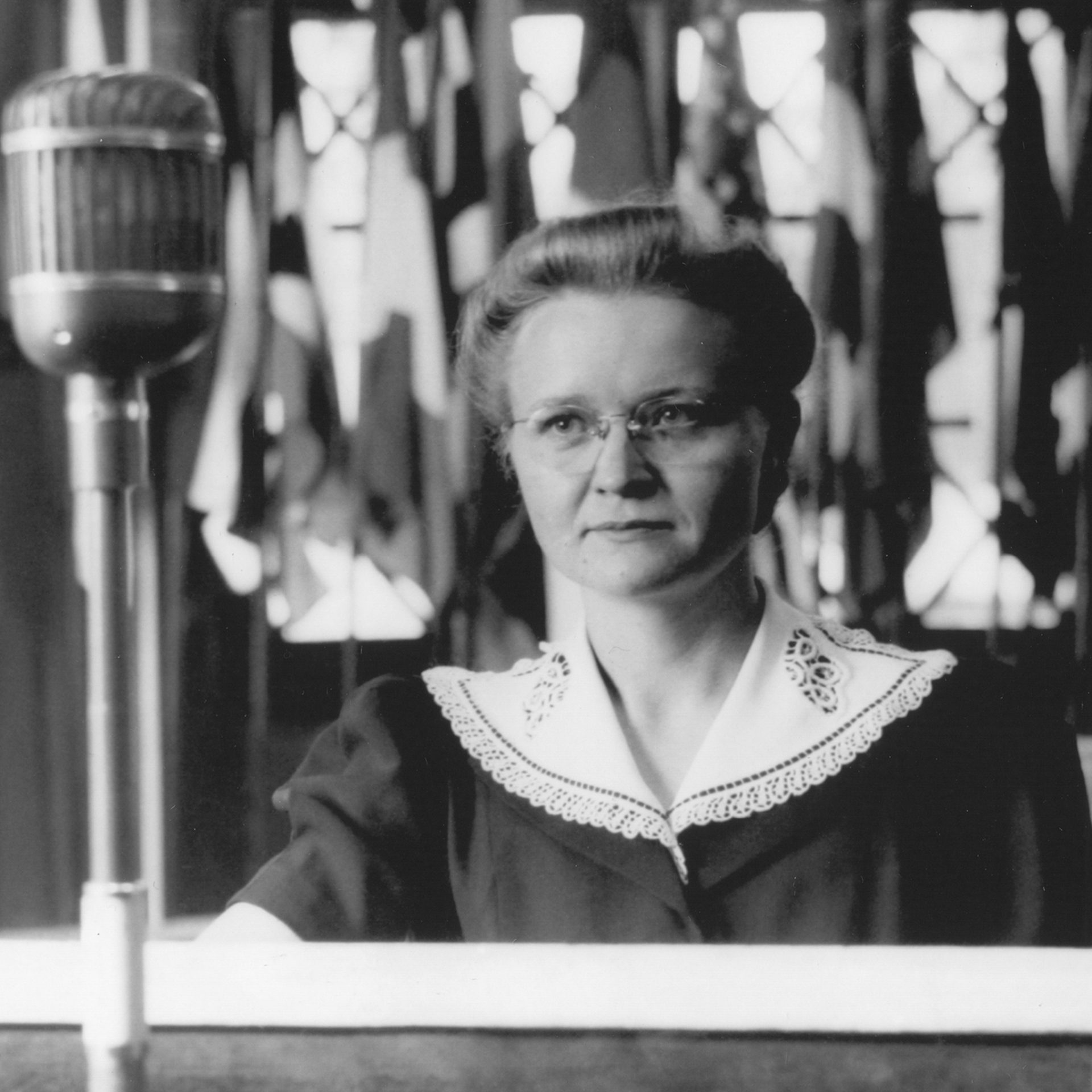
Russian Programs
Peter Deyneka was visiting Quito in early 1941 when he made the first 16 Russian language programs as a test for HCJB. Encouraged by the initial response, Peter and his staff at the Slavic Gospel Association (SGA) in Chicago began recording Russian programs that they sent for broadcast from Quito.
-
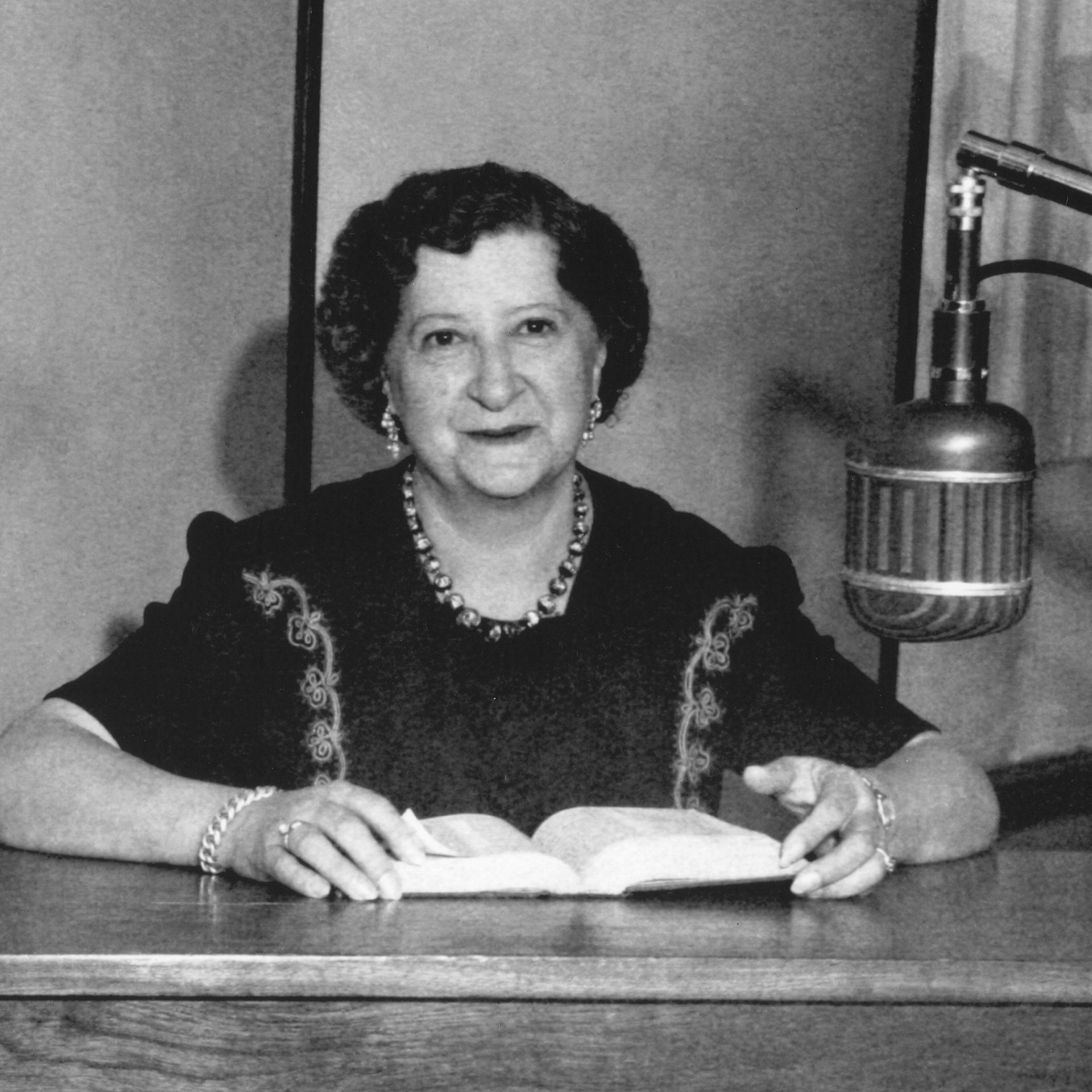
From a Borrowed Radio
Carmela Ochoa was financially unable to purchase a radio in 1932. So, she borrowed one on a trial basis from a local store. After that, she borrowed a radio from a second dealer and then a third. Carmela was one of the first people to call HCJB. A missionary went to her home and gave her a New Testament.
-
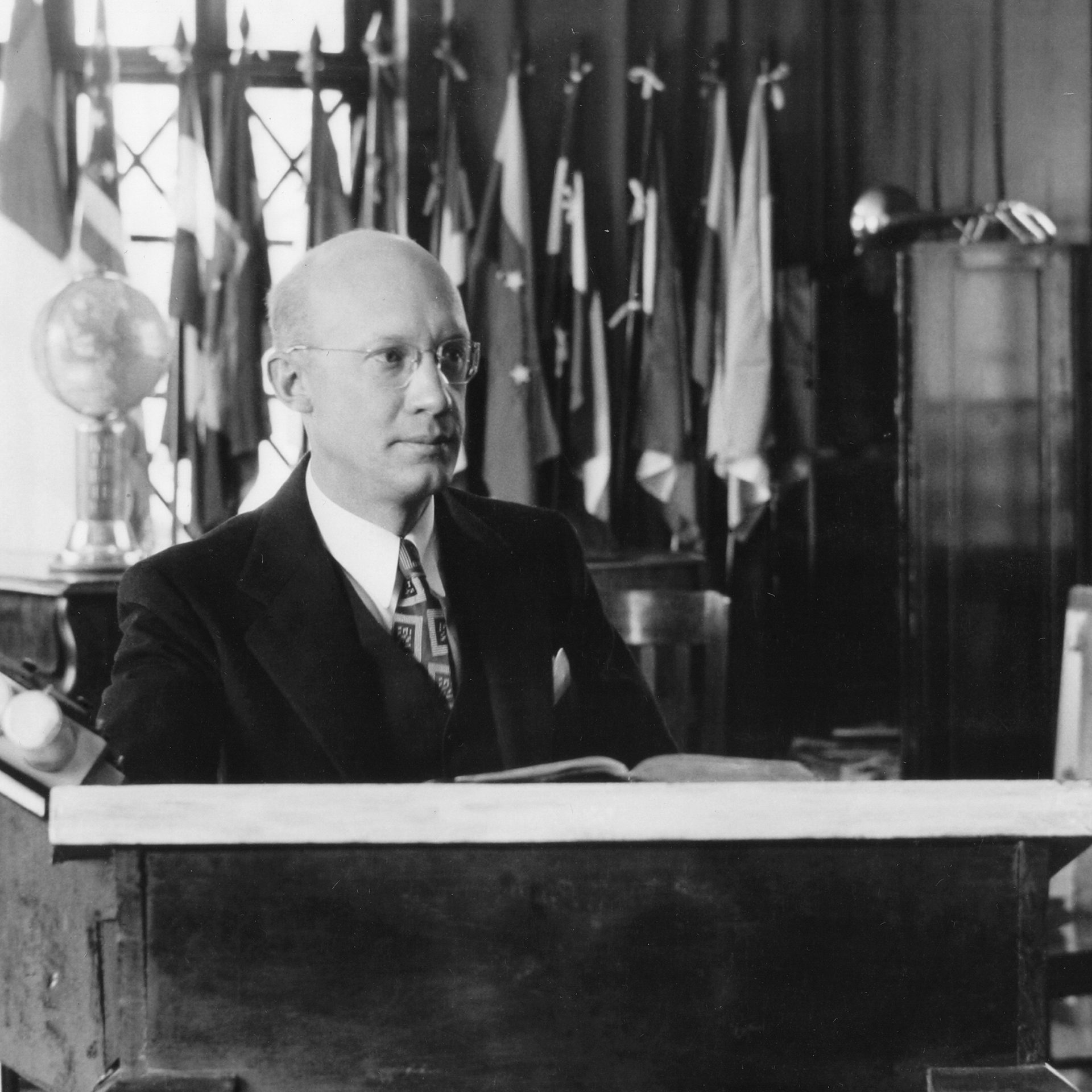
French Programs
Dr. Miner B. Stearns and his wife were missionaries with the Belgium Gospel Mission in Europe. The spread of World War II across the region made it impossible for them to continue their mission work there. But radio could reach past checkpoints, over battle lines and into enemy territory.
-
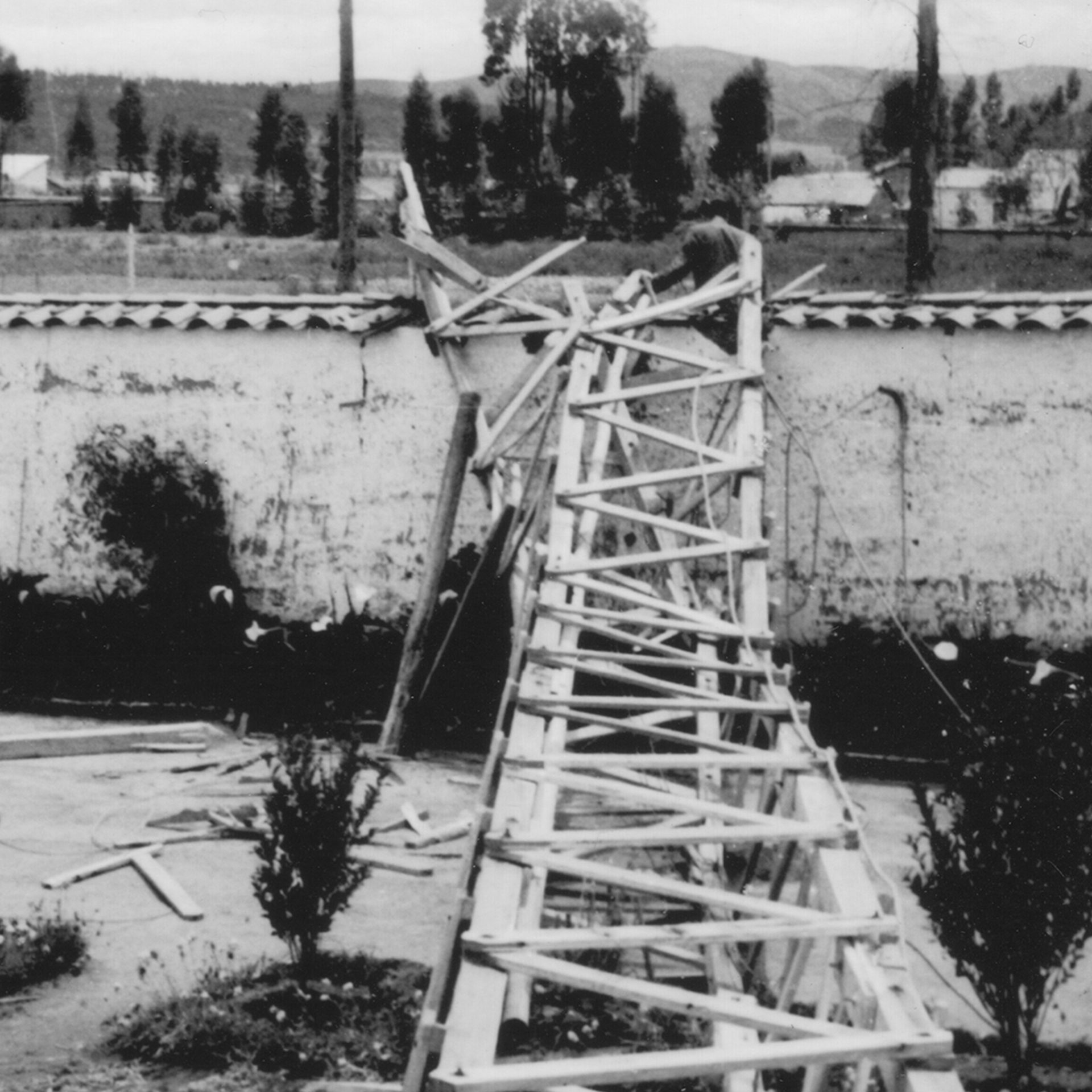
THE DAY THE TONER FELL
On the fateful day we were probably up to a height of about 40 feet and things were progressing smoothly. We were moving one of the guy wires to a higher position so we had just placed the rope substitute in place. Dr. Stearns and I began our climb. I don’t believe we had actually reached the top when the rope anchor slipped where it had been tied on the ground. All I remember is that I felt the tower begin to move and I immediately realized what had happened.
-
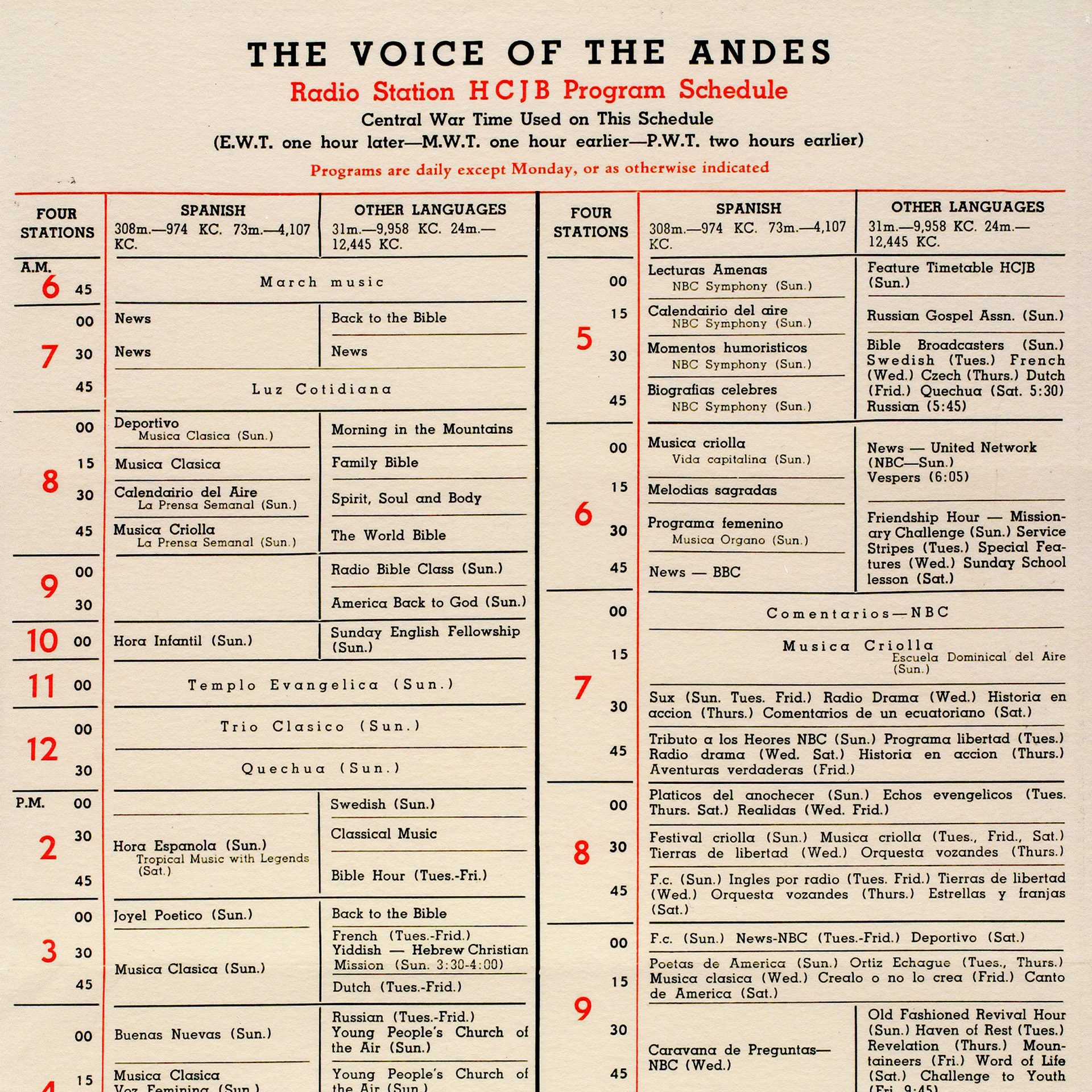
Radio Program schedule – c.1943
After 1940, HCJB began to greatly expand its radio programming. Spanish and English were the primary languages on the schedule, but there were also regular broadcasts in Quichua, Russian, Swedish, French, Czech, Dutch and Yiddish.
-
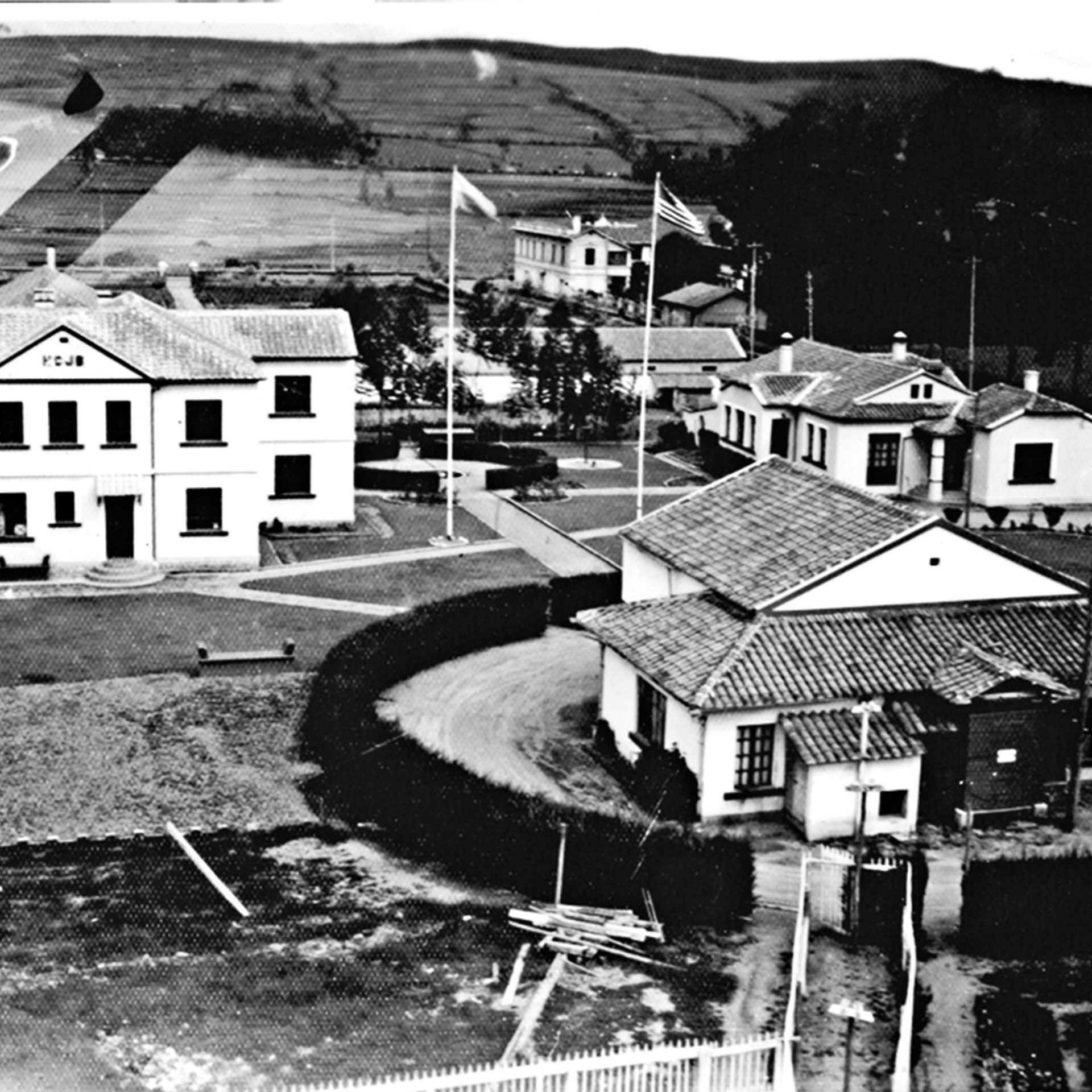
Aerial View of HCJB in 1944
Radio Station HCJB began moving to its current location in 1939. In the foreground is the back of the transmitter building. A second story was added around 1953 when it became the business office. At the back right is the Jones’ home. A radio studio was attached to the right side of their house. The studio controls were actually located in their dining room.
-
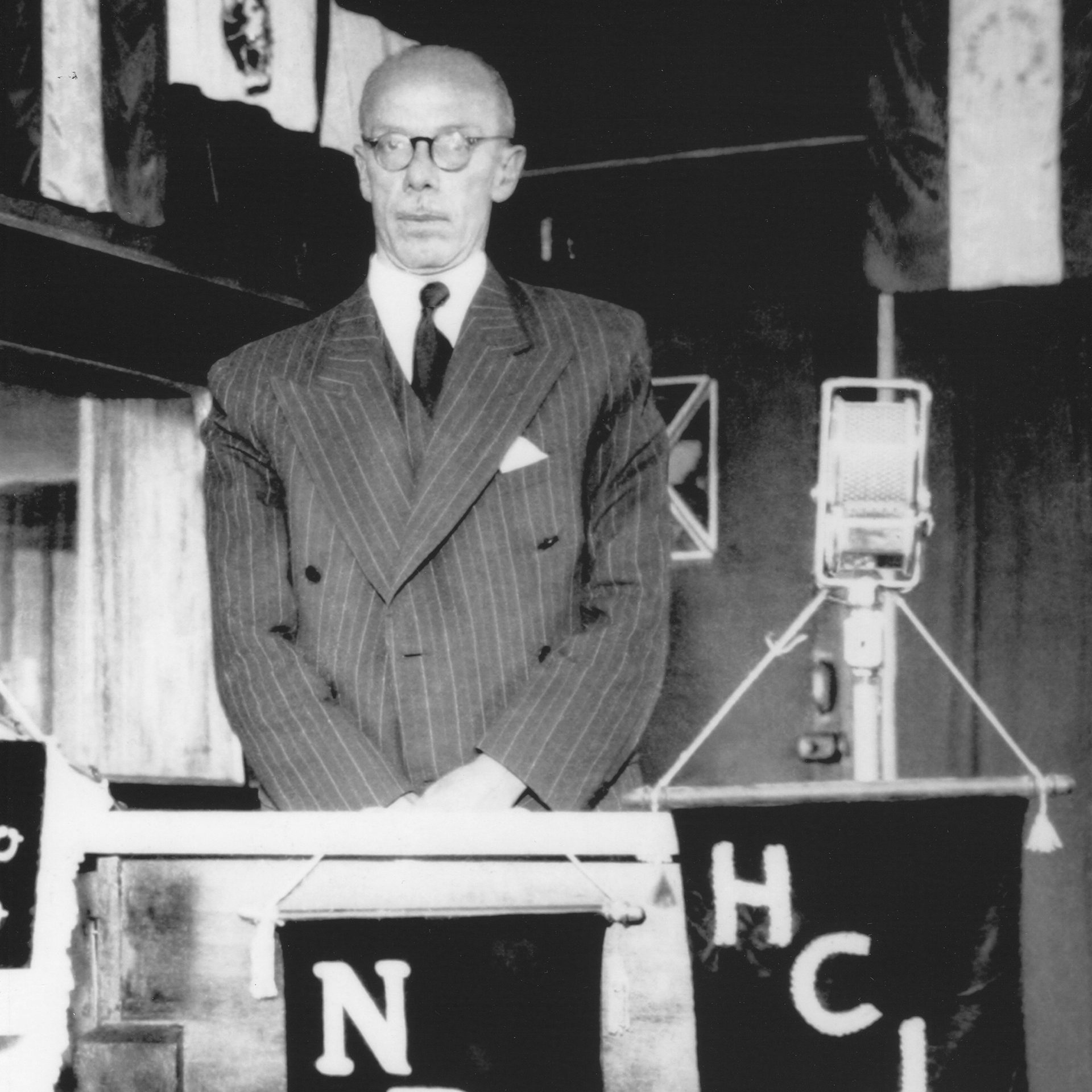
“Give me a balcony in every village and I will become president again.”
José María Velasco Ibarra was President of Ecuador five times. And like most presidents before and after him, Velasco Ibarra used HCJB’s airways to communicate to the people of Ecuador.
HCJB has always made it a policy to only report the news, not try to sway people’s opinions. This has earned HCJB widespread respect for truthful, un-biased reporting of the news. -

Portuguese Programs
HCJB’s Portuguese broadcasts from Quito began with the arrival of Martin Janson and his wife in 1945. The Jansons produced two programs daily. Martin wrote, “It is more than natural that such a challenging opportunity to reach so many millions through the wonderful means of radio with the centuries-old but ever-reviving gospel message would impress with a sense of continuous responsibility…”
-
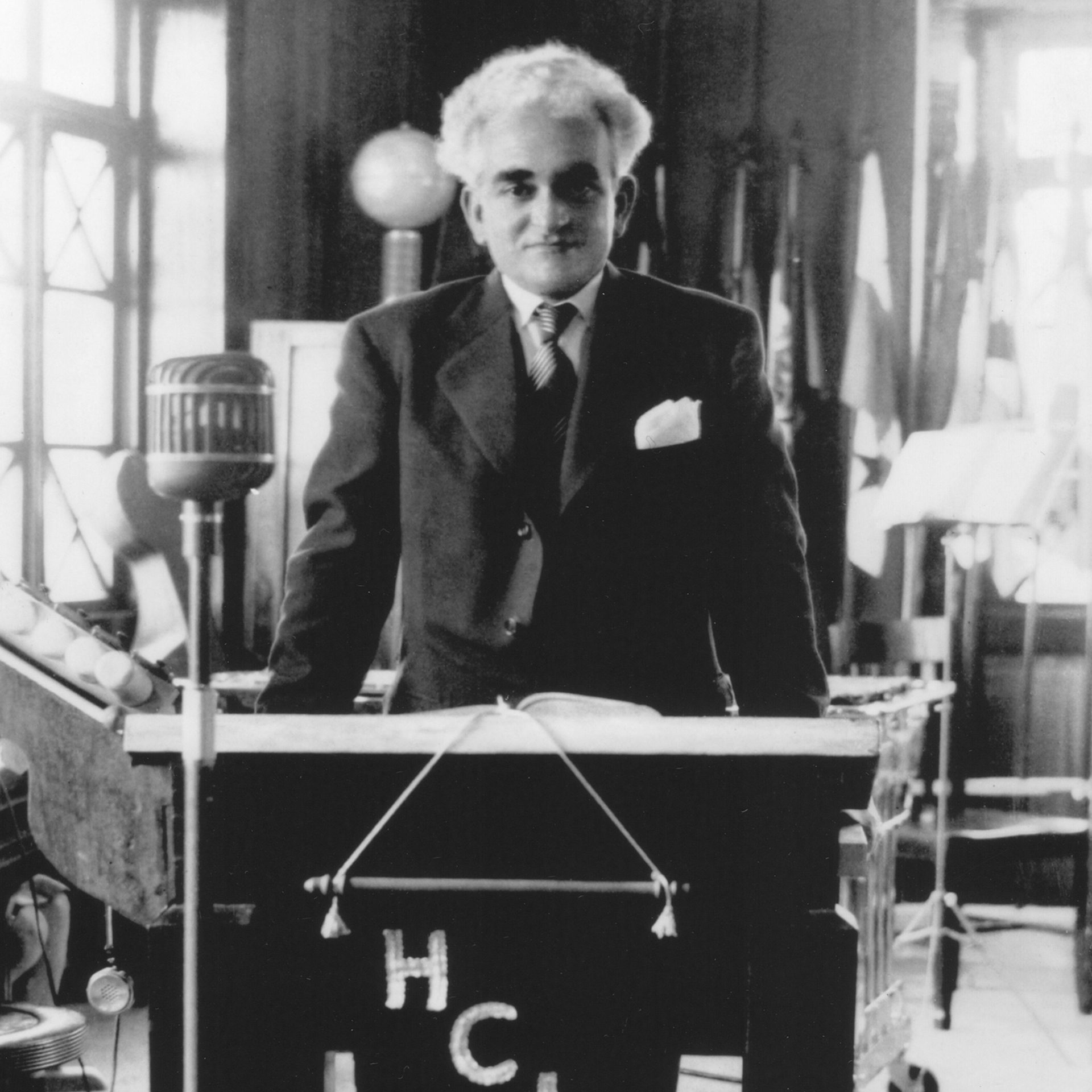
Your Microphone Friends
“The joy of Christ in the faces and lives of Mr. And Mrs. Cabrera is spontaneous and infectious. No one is around them long before he senses that the source of such happiness is the Christ whom they love and serve.
Mrs. Cabrera was born in Madrid and Mr. Cabrera in Cuba… Many thousands have heard their messages in Spanish and English over HCJB…” -
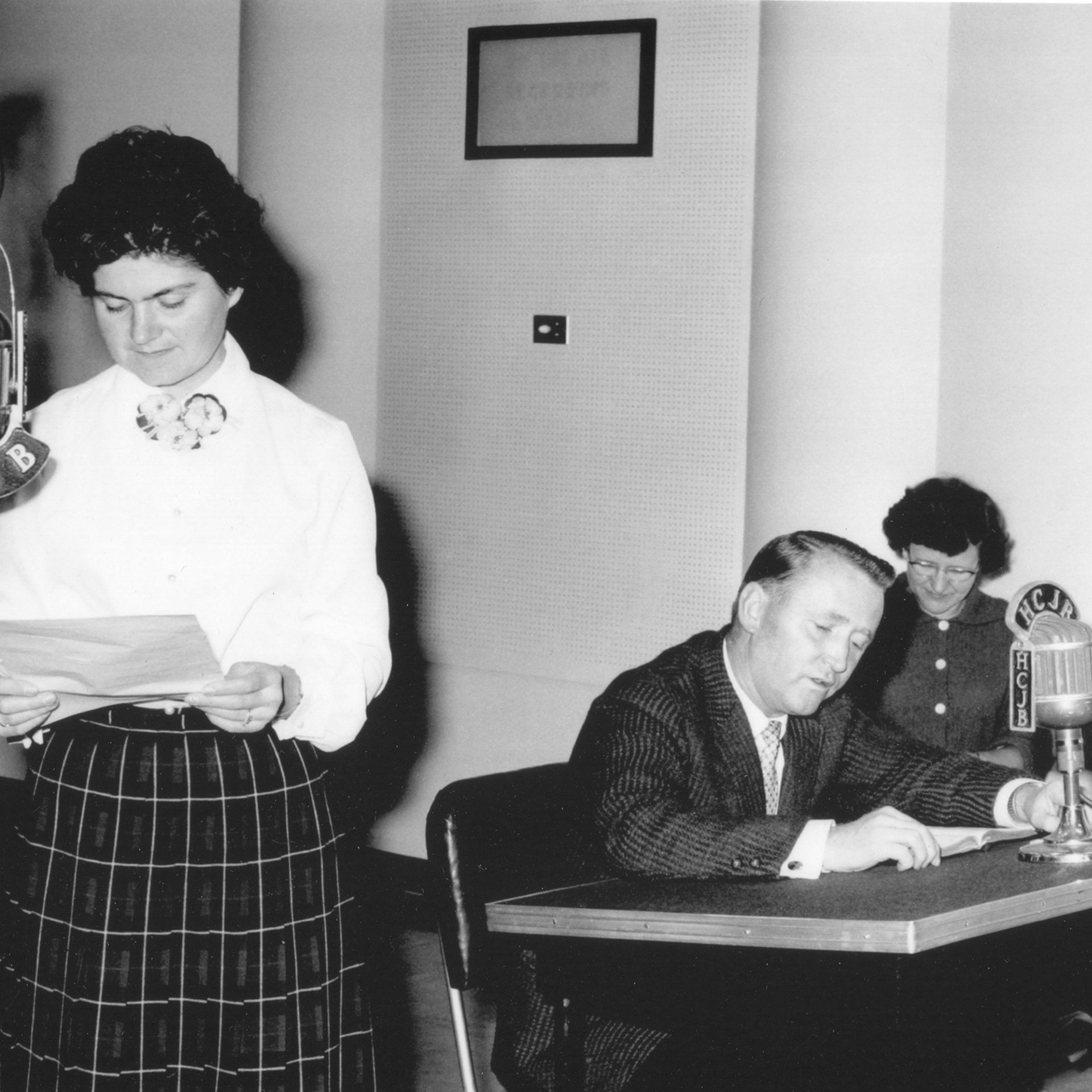
Programs in German
In 1945, HCJB began broadcasting a weekly 15-minute live program in German by volunteer Otto Seidlitz.
The mission, however, wanted full-time staff that could expand the amount of German programming and better correspond with listeners. -
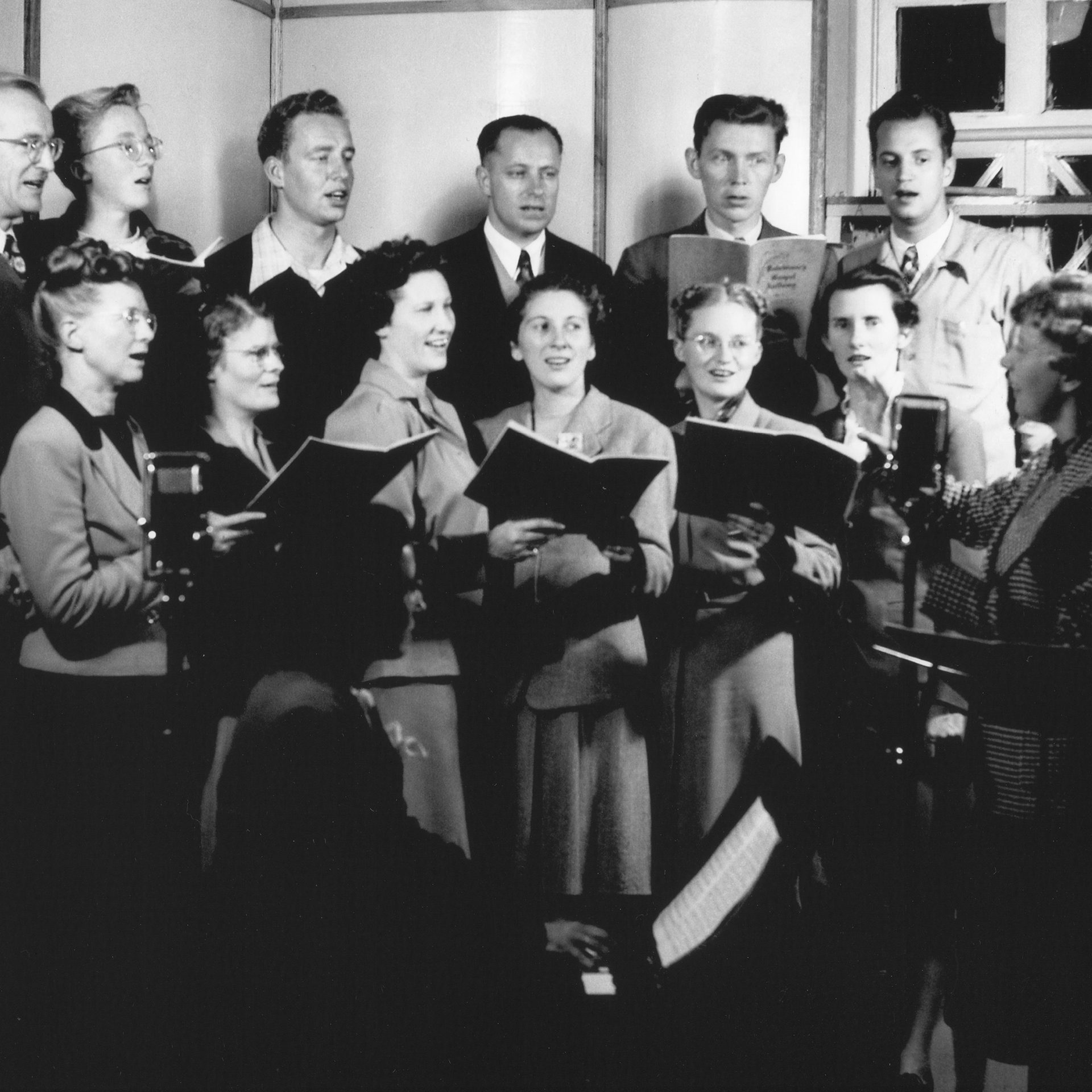
English Programs
English programming began with HCJB’s first program on Dec. 25, 1931. HCJB staff produced a variety of English programs for listeners of all ages living in many different countries.
-

Beginning of HCJB’s Medical Ministries
With the arrival of Dr. Paul and Barbara Roberts, and nurse Kay Erb in 1949, HCJB began two medical clinics. The first clinic was for missionaries and HCJB’s staff. The clinic was on the first floor of the Robert’s home on “Calle San Francisco.” The second medical clinic was part of HCJB’s indigenous hostel on the Pan American Highway at 10 de Agosto y Carondolet. For one sucre, indigenous guests at the hostel had a place to spend the night, hot water and soap.
-
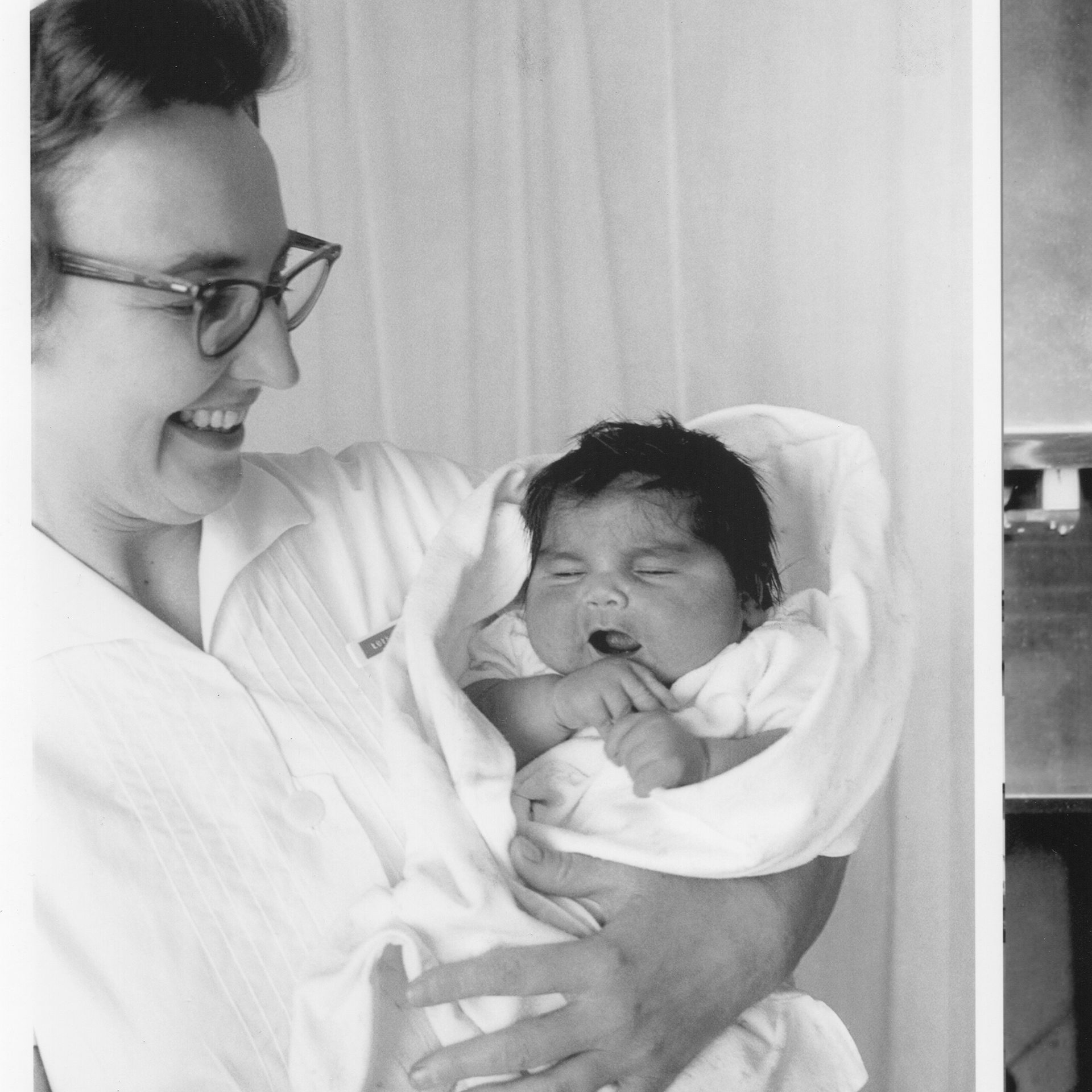
The Inspiration for HCJB’s Medical
The birth of a baby is usually a joyous occasion (baby held by nurse Lois Baklenko). That joy turned to sorrow for Reuben and Grace Larson when their son, Robert Lee, died shortly after being born at the Jones’ Quinta Corston home. Clarence and Katherine Jones experienced the same sorrow when their daughter Elizabeth Pearl died just two days after birth.
-
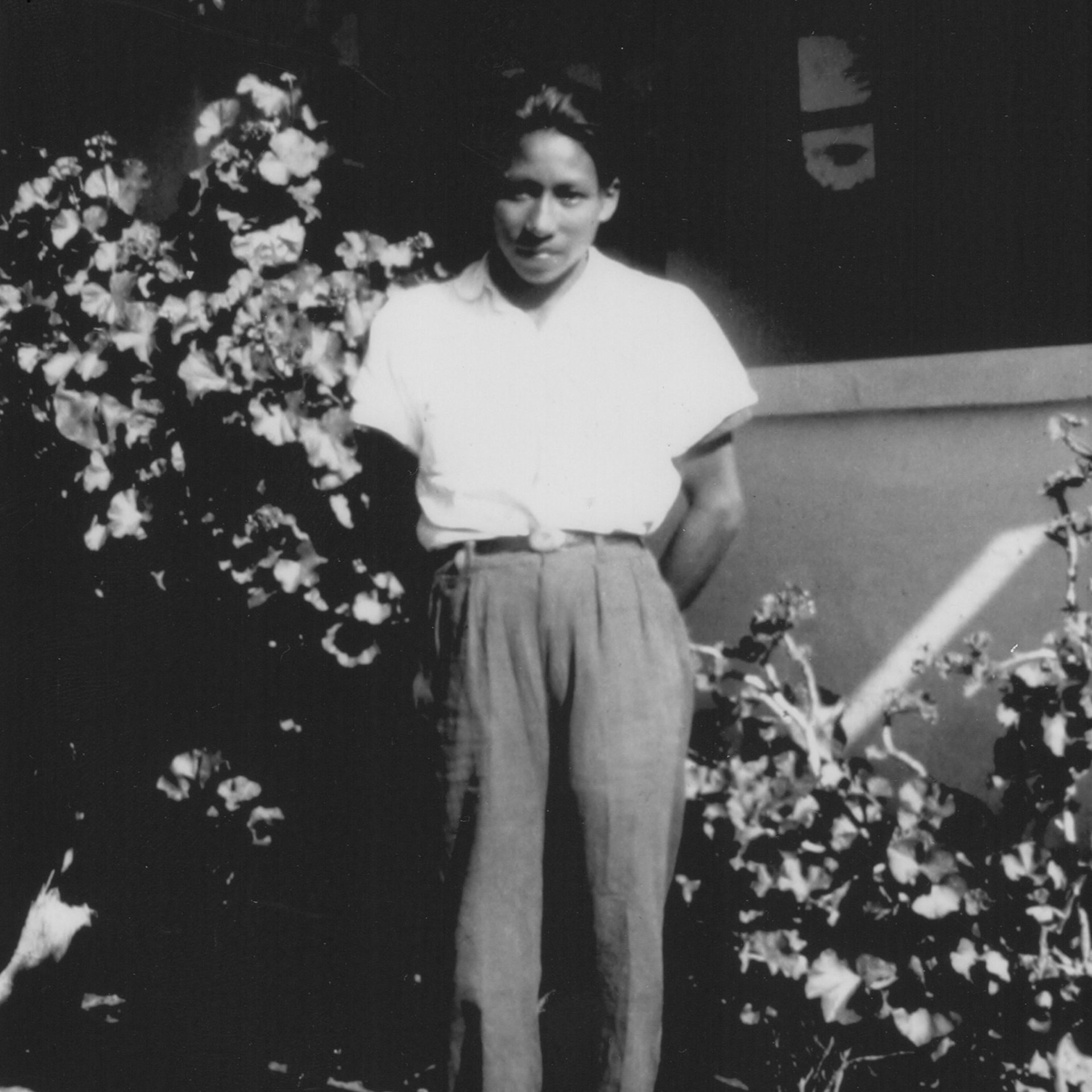
The First Patient
In October of 1949, Dr. Paul Roberts and nurse Kay Erb treated the first patient at the medical clinic. This first patient came to the clinic suffering from severe amoebic dysentery.
-
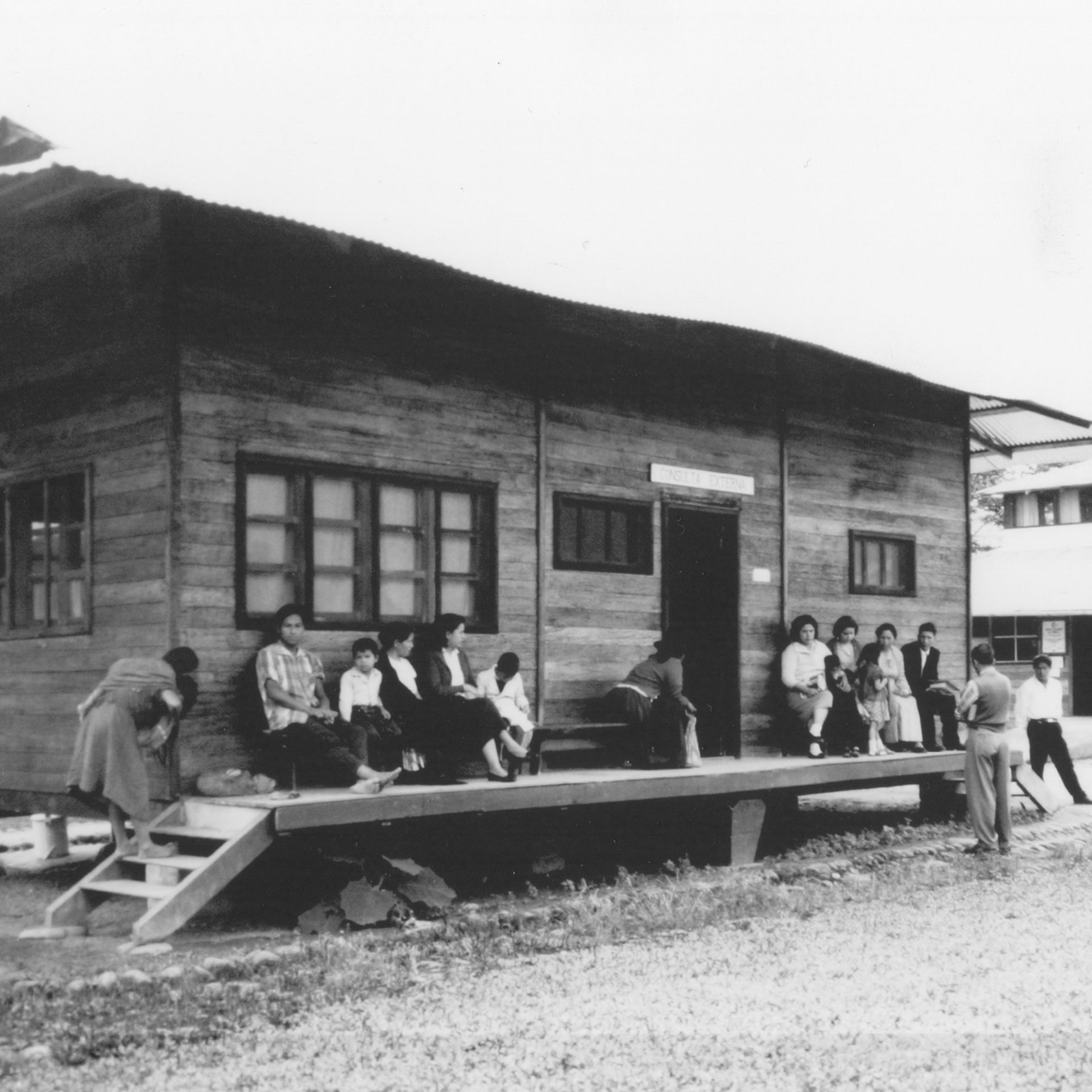
Nate Saint’s Dream for a Clinic in Shell
As a pilot, Nate often saw people in the jungle who needed medical help. As a nurse, his wife, Marj, was frequently called upon to give treatment. Nate shared his vision for a clinic or hospital in Shell with Dr. Ev Fuller in early 1950. Dr. Fuller immediately realized that this was what God wanted him to do. Before long he and Nate had built a small clinic and Jim Elliot did the electrical wiring.
-
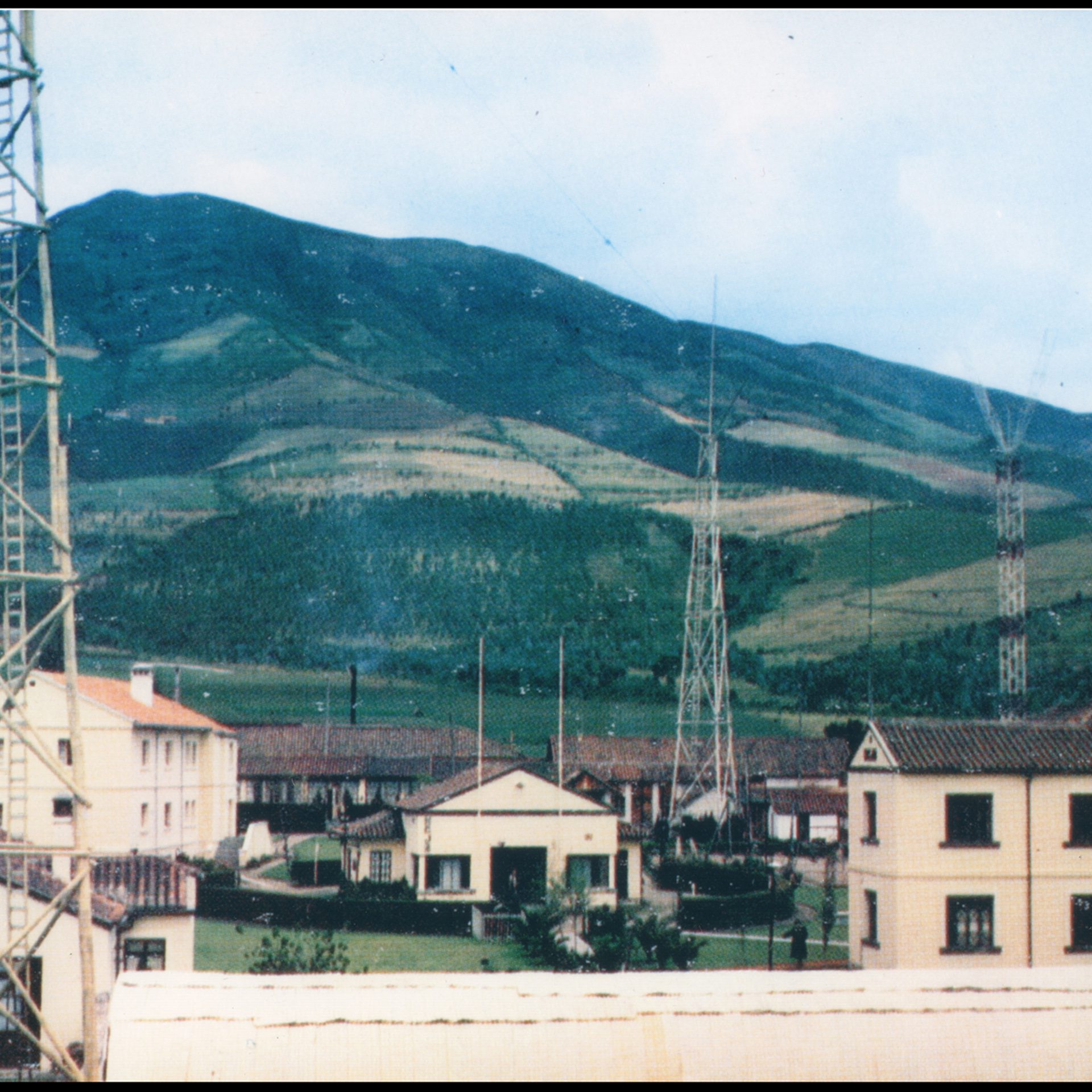
HCJB Compound – c.1952
By 1946, the directors of HCJB began looking to move the radio transmitters and antennas to a new location. HCJB’s compound was becoming crowded and Quito’s city limits were moving ever closer. HCJB’s radio towers consisted of simple wooden poles bolted together.
-
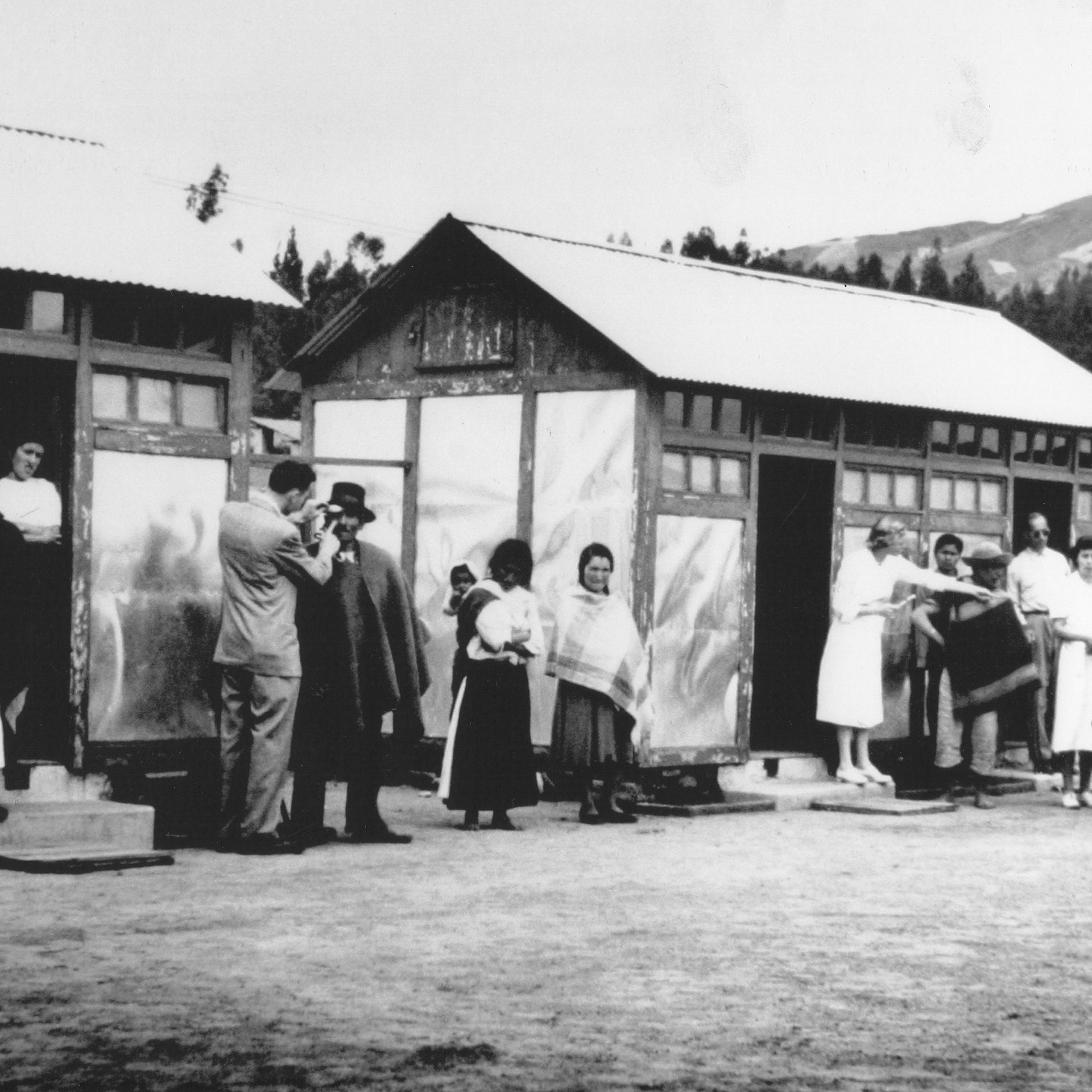
Hospital Vozandes-Quito and the lñaquito Evangelical Church
Before long, missionaries began seeking ways to better meet the growing needs of the people around the indigenous hostel and clinic. Dr. Paul Roberts was quickly burdened with the need for a modern fully-equipped hospital. That dream became Hospital Vozandes-Quito. His wife Barbara, with help from other missionary women, started a Saturday kids’ Bible club at the clinic. A small church was also started at the clinic. These two ministries were the beginnings of the lñaquito Evangelical Church.
-

Hospital Vozandes-Quito
Dr. Paul Roberts had a much larger vision than a small indigenous clinic. He wanted a large, modern hospital where everyone could receive the best medical care possible, regardless of race, social status or ability to pay.
-
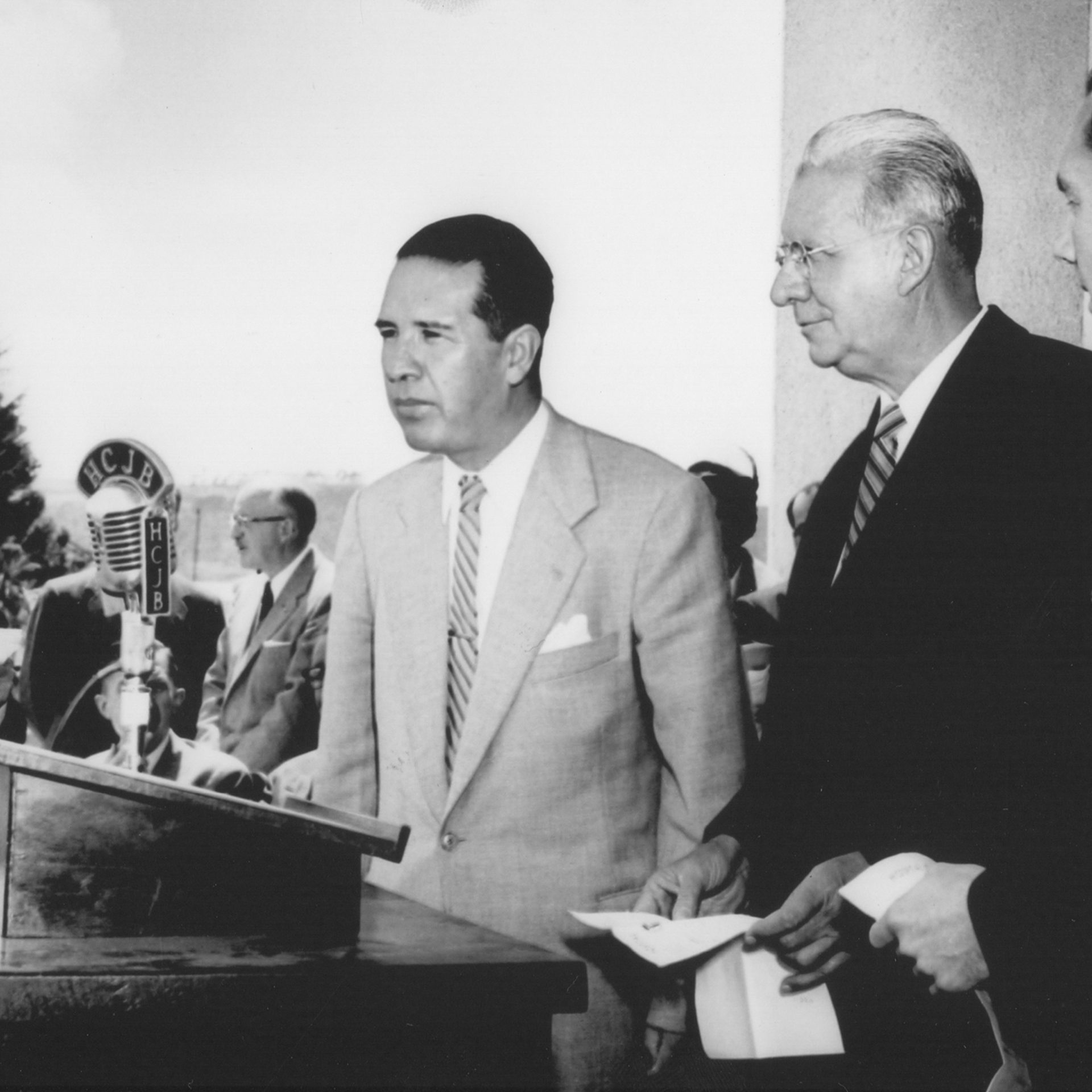
A Cheerful Beginning
Dr. Paul Roberts’ dream of a modern hospital became a reality with the inauguration of Hospital- Vozandes Quito on Oct. 12, 1955.
-
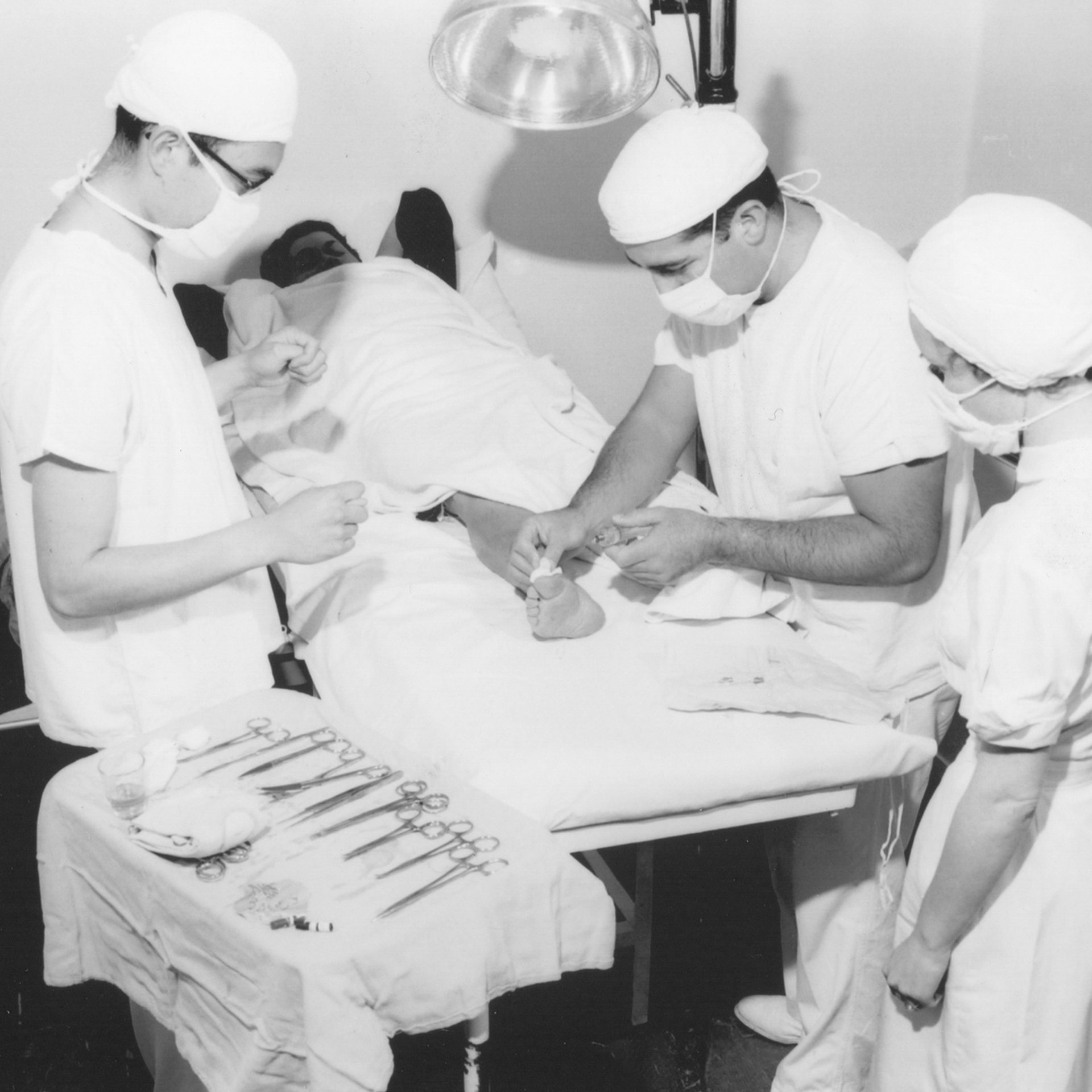
A Teaching Hospital
Dr. Paul Roberts wanted the hospital to be a teaching hospital that could help improve health care in Ecuador.
-

50,000 Watts
By the 1950s, the shortwave bands were becoming crowded. For HCJB to be clearly heard around the world, it needed to increase the power of its radio signal. It was decided to add a 50,000-watt transmitter, which was very powerful at the time. HCJB engineers completed construction of this large unit in 1956.
-
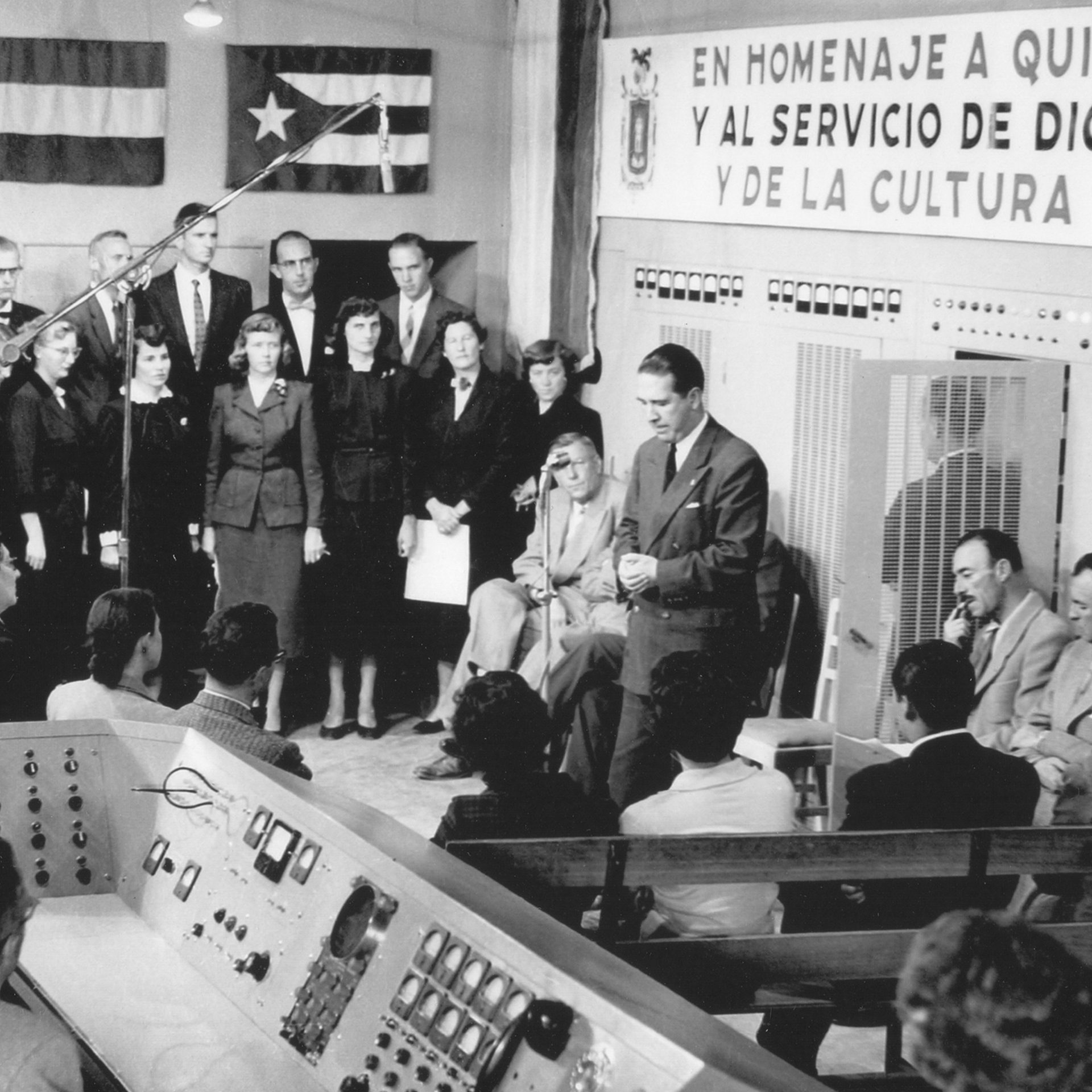
Full Circle
Carlos Andrade Marín was working as a secretary for the president of Ecuador in 1930 when HCJB applied for a radio contract. The President initially left the contract unsigned. So Carlos placed it on top of the papers given to the president each morning until he finally signed it. Twenty-six years later, as Mayor of Quito, Dr. Carlos Andrade Marín (at microphone) helped inaugurate HCJB’s new 50,000-watt transmitter. Former President of Ecuador, Galo Plaza Lasso, also took part in the celebration.
-
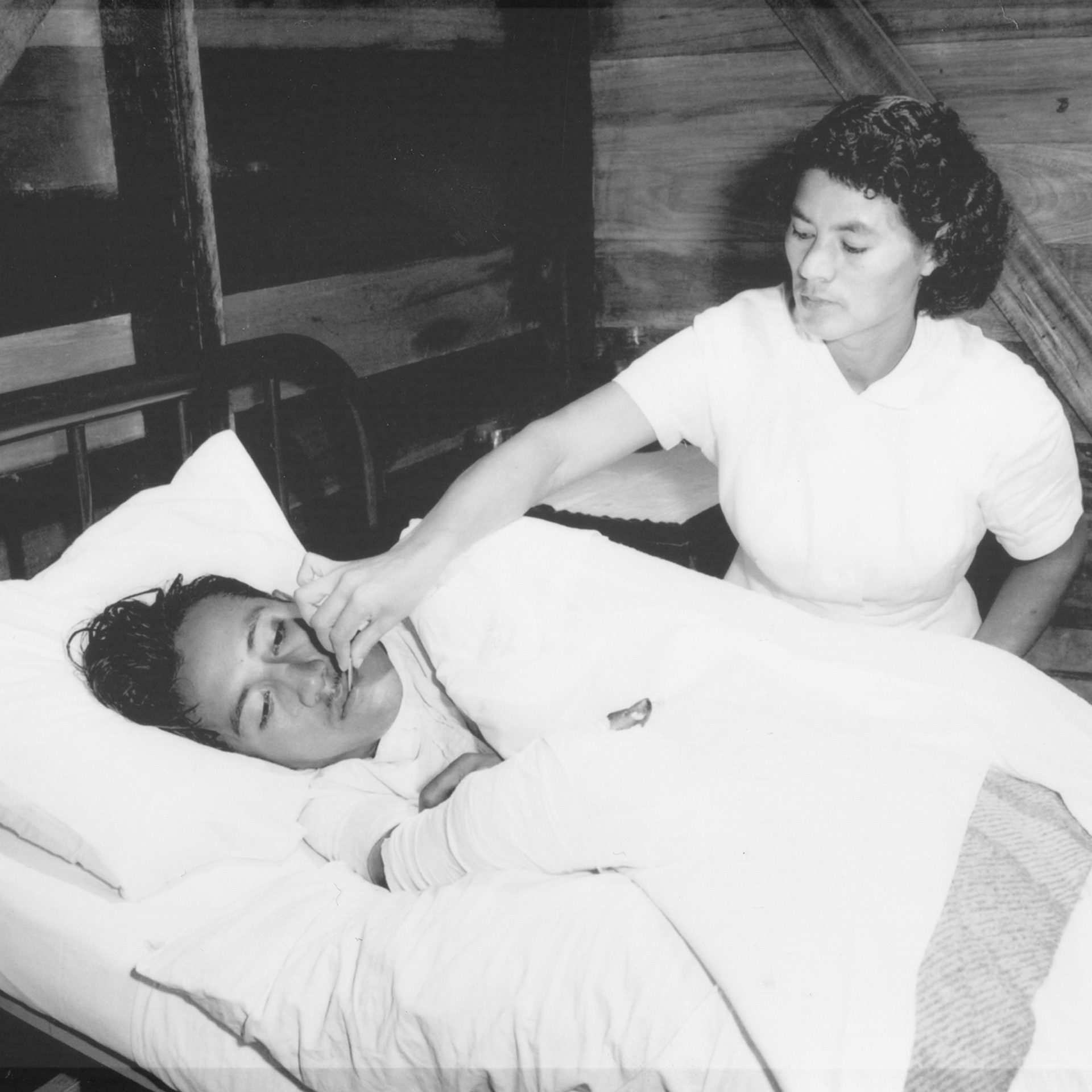
Hospital Vozandes del Oriente
Patients of the Shell medical clinic with serious medical needs were «hospitalized» at a nearby hotel. The need for a true hospital quickly became obvious and plans for one were put together. Missionaries from many different missions joined in construction of Hospital Vozandes del Oriente, which was completed in 1958. The radio ministry «Back to the Bible» raised much of the funds to build the hospital.
-
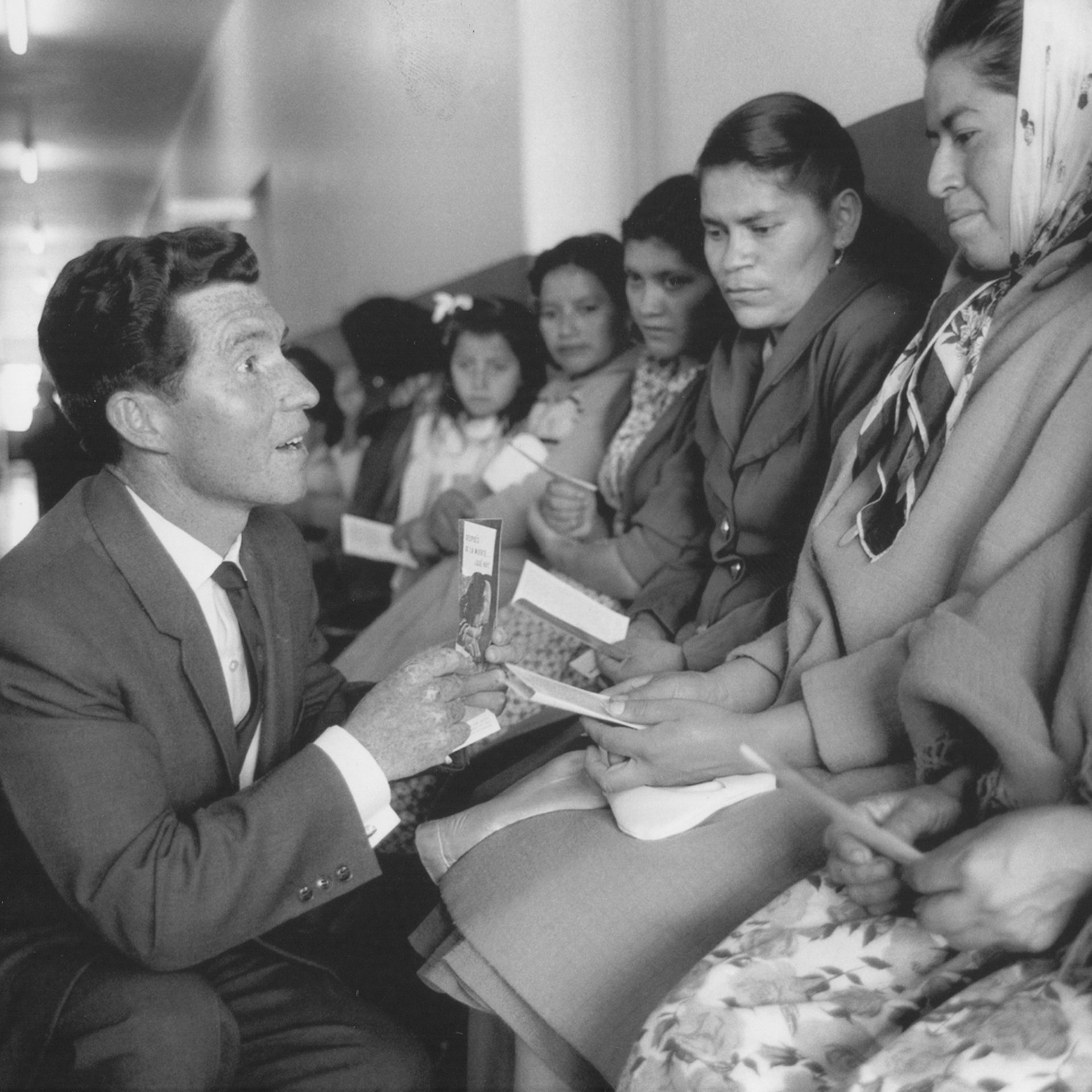
Treating the Whole Person
Gustavo began ministering at the hospital in 1958. He prays each morning that God would show him whom he should help lead to the Lord. As a result, Gustavo has helped bring eternal spiritual healing to thousands of patients and their families.
-
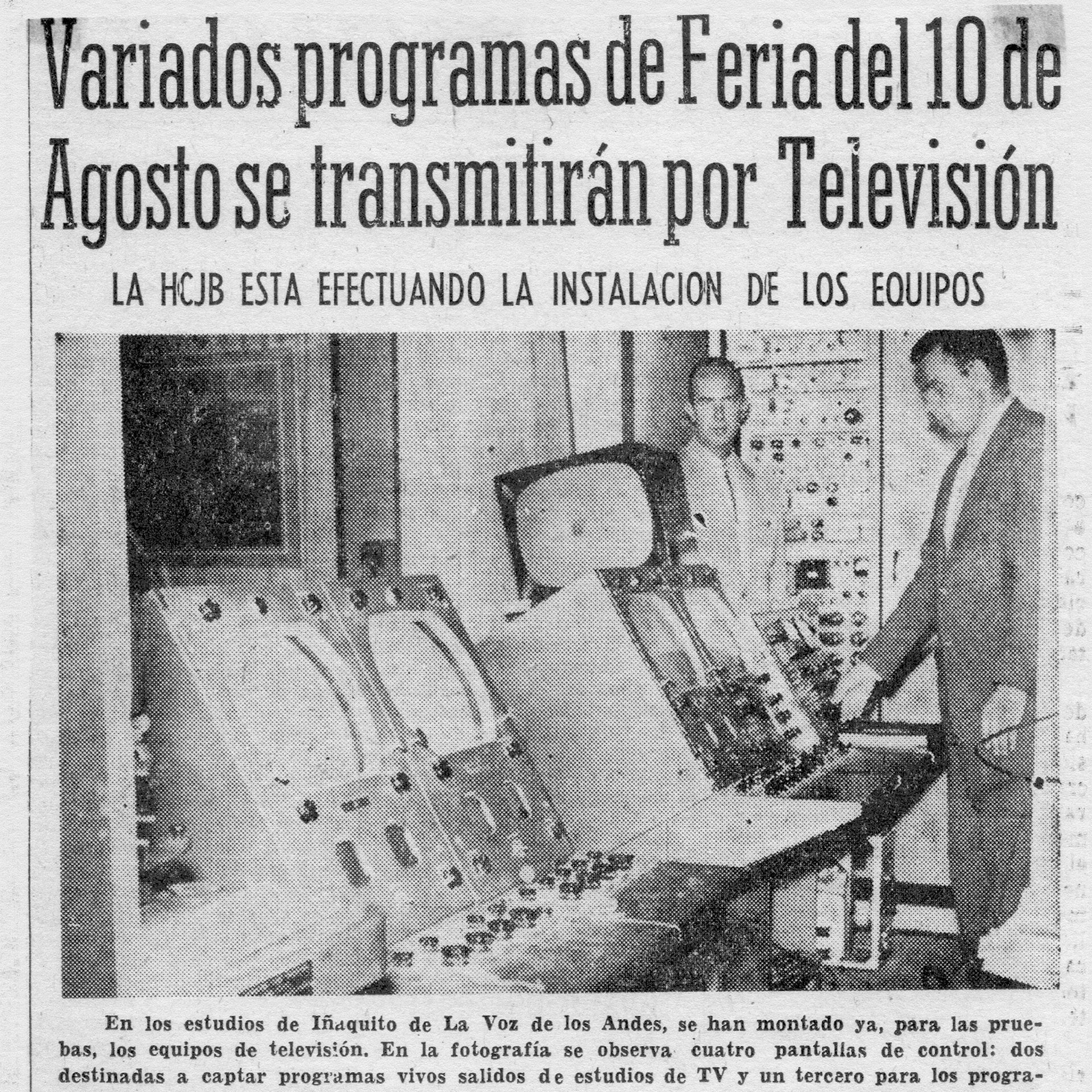
HCJB-TV: Out of a Garage
Shortly after Giff gave his life to Christ, he felt led to build a missionary television station. Over several years, he invested some 2,000 hours assembling a complete television station in his garage, mostly from scrapped parts. Giff and his wife, Ginny, gave the equipment to HCJB and then joined the mission to help get the television station started.
-

Window of the Andes
On August 10, 1959, HCJB made the first television broadcast in the country of Ecuador. Many in Quito were eagerly awaiting the arrival of television. More than 250 TV sets had been sold before the first broadcast. People crowded around televisions in homes or wherever they could find one. Some restaurants even advertised that their customers could watch HCJB-TV while enjoying dinner.
-
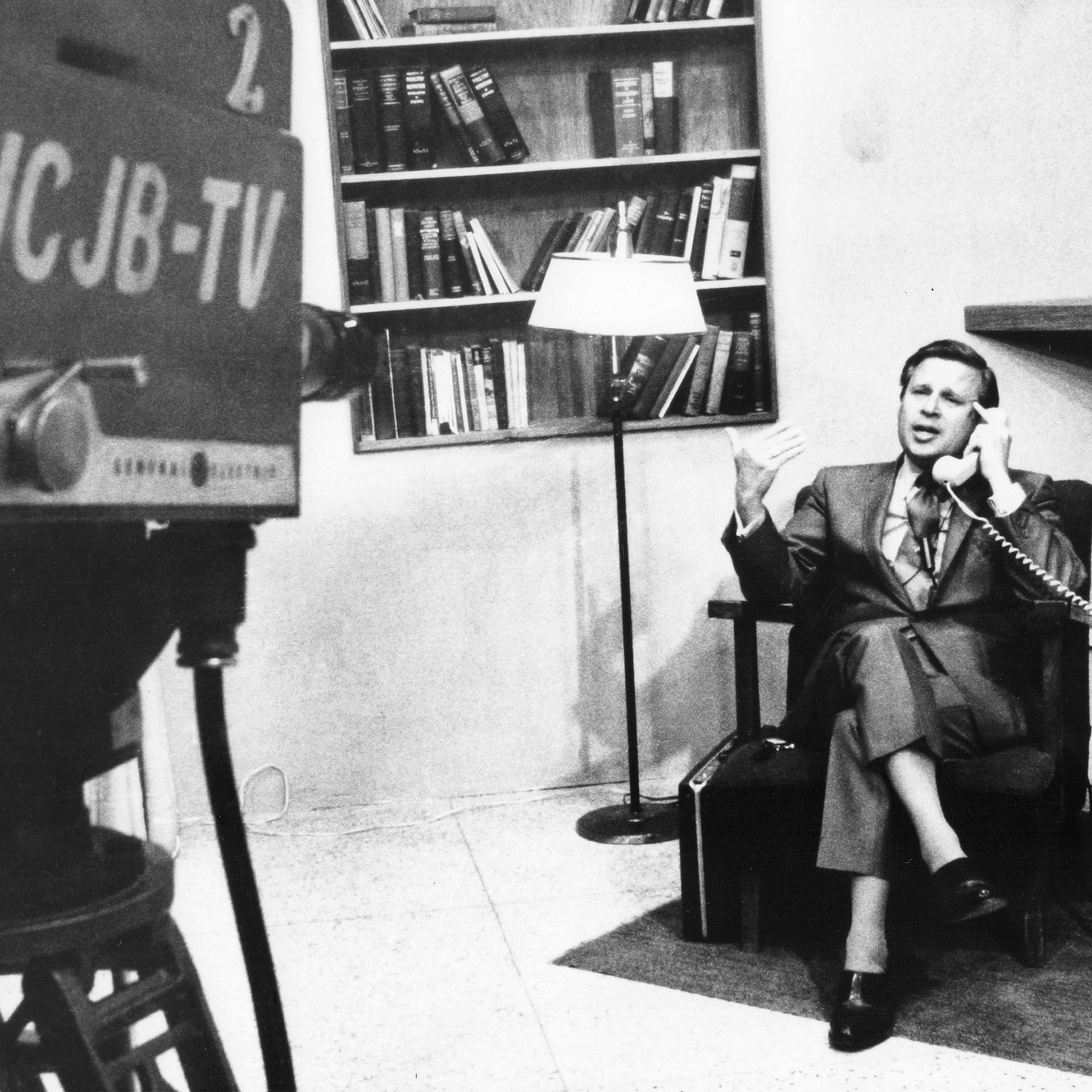
TV Evangelism
One of the primary purposes of HCJB-TV was to share the gospel with people in Quito. Many of HCJB’s staff were involved in making the live evening programs. Well-known evangelists like Hermano Pablo above, Billy Graham below and Luis Palau appeared on HCJB-TV.
-
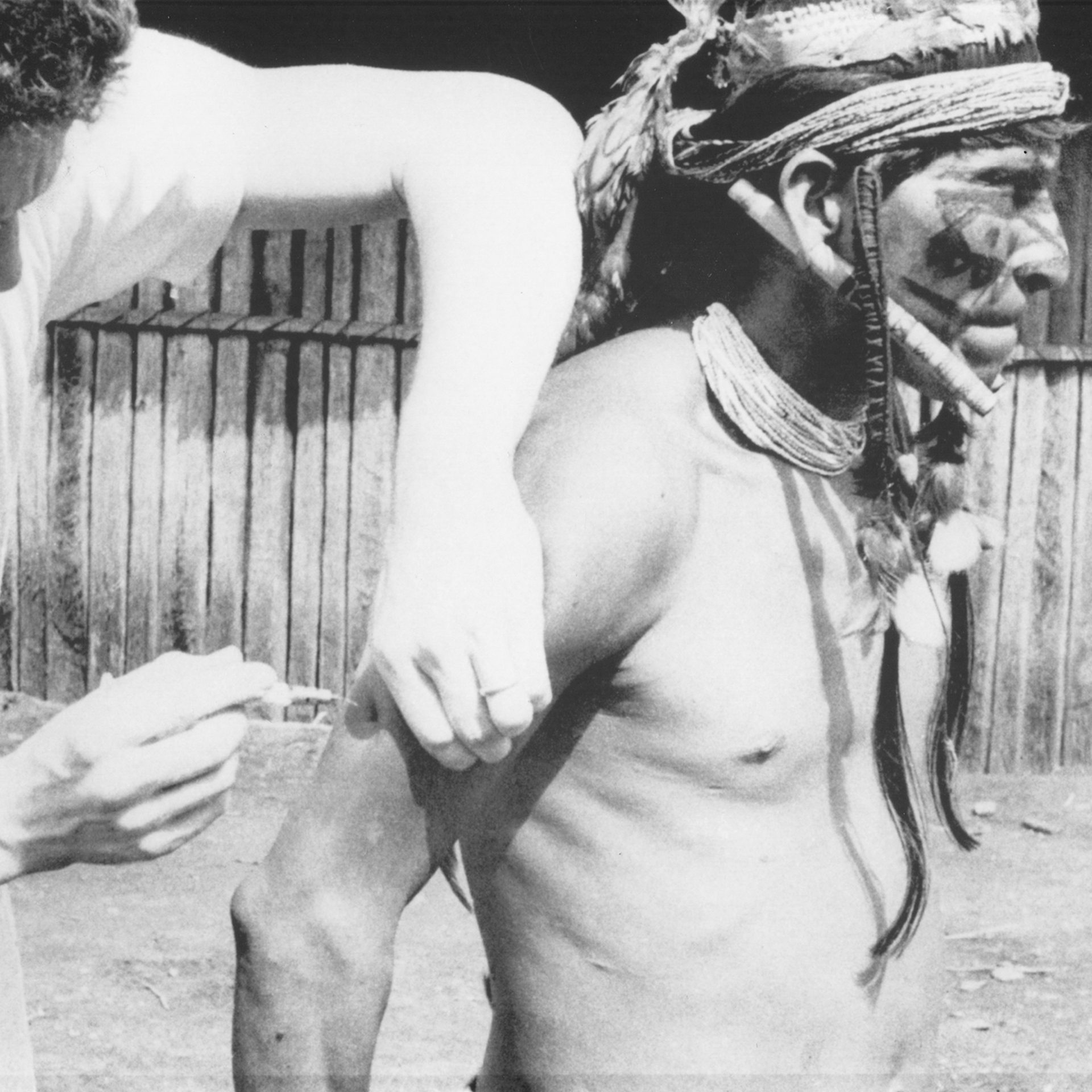
Jungle Communities
The medical staff in Shell regularly visited and treated communities in the jungle. In 1961, a polio epidemic occured among the Waoroni, resulting in immediate action by HCJB doctors and nurses, and thus saving many lives.
-
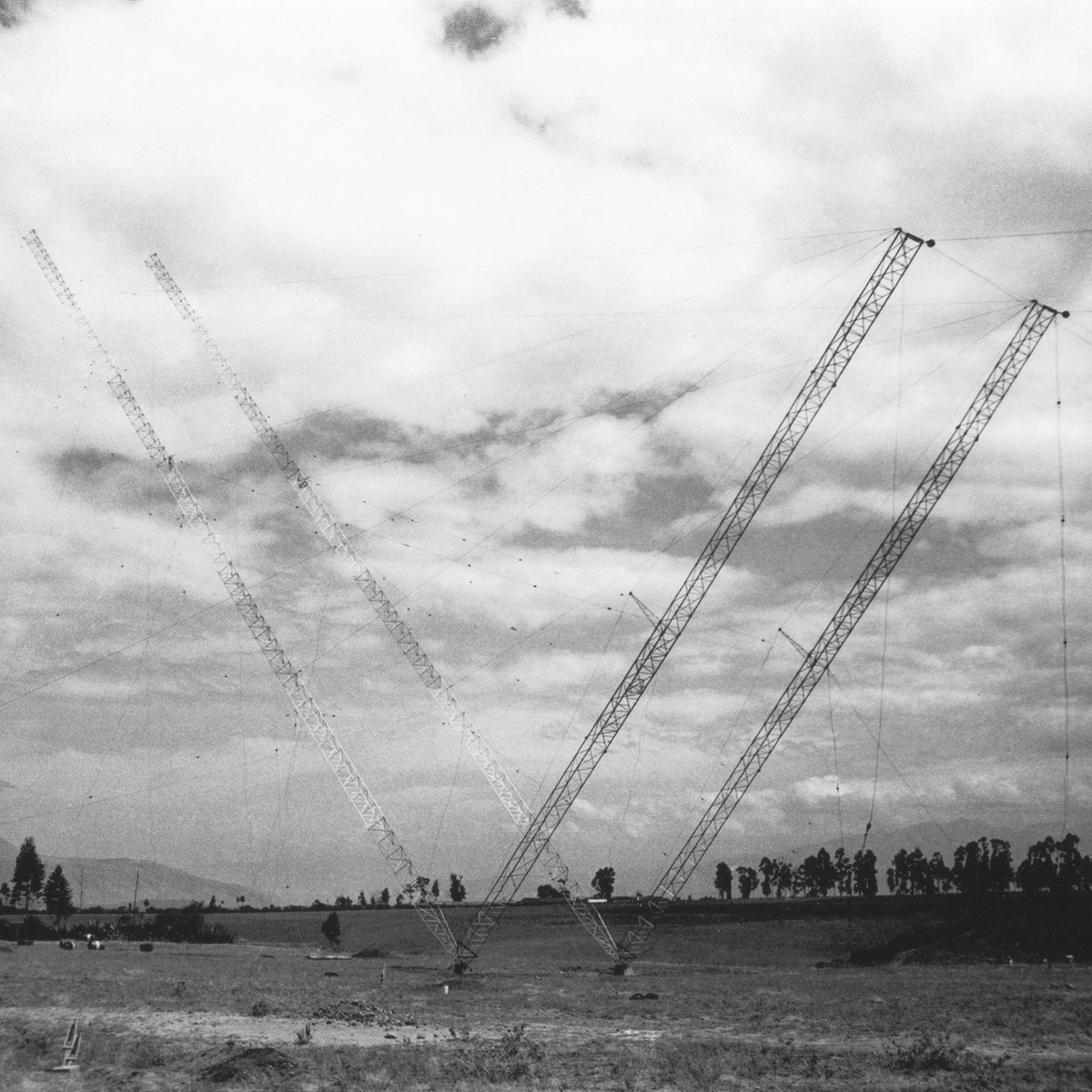
Raising Towers: Two at a Time
In 1963, HCJB’s engineers began working on a new antenna array for shortwave broadcasts to Europe and the South Pacific. To raise the towers, engineers adapted a technique that used a second smaller tower as a lever. This new method was much safer since it raised an entire tower at once, rather than in sections. Using a single four-wheel-drive military surplus truck, they pulled up two 240 ft. towers at the same time!
-

Why don’t we get more letters?
HCJB’s first Japanese broadcasts used recorded programs sent from Japan by Kazuo Ozaki and the Pacific Broadcasting Association. Before long, it was discovered that some of those tapes were being played backwards. So Kazuo and Hisako Ozaki moved to Quito where they began making Japanese programs in May 1964.
-
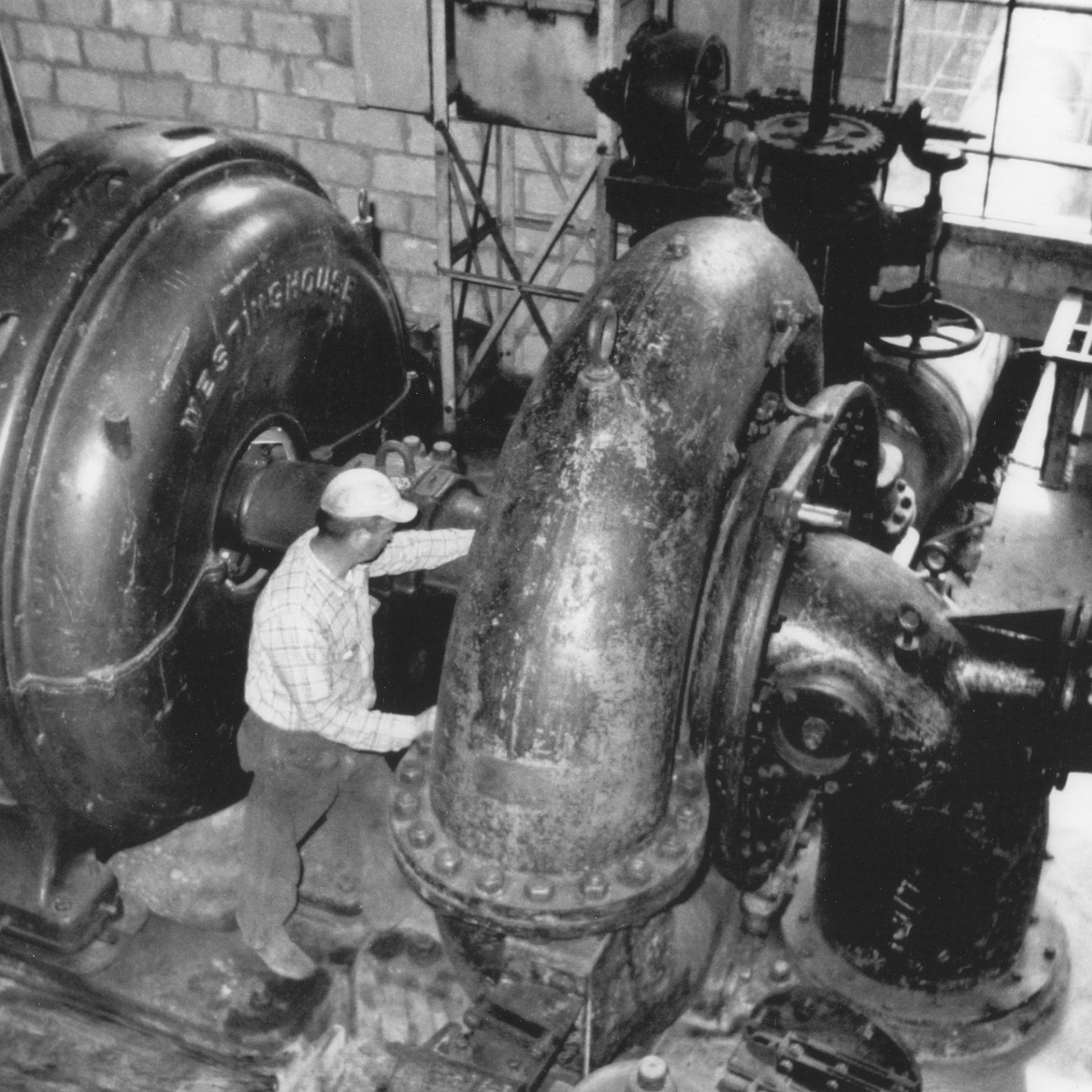
Hydro Power
By the late 1950s, the cost of using diesel generators to power HCJB’s broadcasts had skyrocketed. Technical staff began looking at building a hydroelectric plant by the Papallacta River to greatly reduce the cost of electricity.
Bob Wittig found a used hydroelectric generator in the U.S. for a near scrap metal price. Staff constructed a dam and a large pipe to send water 440 feet down to the turbine-generator. The 1.8 megawatt project at Papallacta was completed in 1965.
-

The Beginning of Radio in Ecuador
Radio was virtually non-existent in Ecuador in 1930. As far as it could be determined, there were only six radio receivers in the entire country. So Clarence Jones arranged for Reed & Reed to import and distribute radios. He also sold radios personally through his Quito Radio Agency.
But HCJB was not the first to broadcast via radio in Ecuador. In 1925, Carlos Cordovéz, an electrical engineer and inventor, made the very first experimental radio broadcast in Ecuador. From his amateur station “ el Prado” in Riobamba, Cordovéz made a two-hour broadcast each Thursday night from 1929 until 1939 -

HCJB on the «Silver Screen»
Clarence Jones visited Ecuador in October 1930. He used a borrowed movie camera to make what was perhaps the world’s very first missionary film.
The movie introduced the people and country of Ecuador to audiences across the United States. The film also introduced to many the letters HCJB – Heralding Christ Jesus’ Blessings. -

How do you share the gospel with people scattered throughout the jungle?
This was not an easy task for Reuben and Grace Larson; the local Quichua Indians ran away and hid from them! Reuben decided that building a trading post at Dos Rios could bring people right to his doorstep. At first, they traded matches, machetes and various trinkets for food for their family. As the Larsons reputation for honesty grew, they distributed salt, delivered mail and bought gold for the Ecuadorian government. Reuben also oversaw the maintenance of local schools and trails in the area.
-
Can you think of a better place?
Radio station HCJB had a rather humble beginning. Money was scarce and Clarence had to be resourceful. He needed to find a suitable place for the transmitter and for a workshop.
On the Quinta Corston property was an old sheep shed that was essentially just two mud walls and a roof. Jones and a helper closed in the open sides, added windows, poured a concrete floor and whitewashed the whole building. -

For One Sucre…
The station needed towers to support the radio antenna. But how could Clarence Jones and Eric Williams build them? The solution was to ask the Quito Electric company for their two tallest poles. The 85 ft. eucalyptus poles soon arrived at Quinta Corston. Two holes for the poles were dug 200 feet apart. They attached pulleys to the tops of the poles and quickly hoisted them up into place.
-

HCJB Engineers and Technicians
It was essential for Radio Station HCJB to have staff that could maintain and repair the radio transmitters. The lack of finances to purchase commercially built models meant that most all HCJB’s early radio transmitters were built by HCJB staff.
-

More than just a Home
On the Quinta Corston property was a charming ivy covered «cottage» built by the former Scottish owner. The Jones’ shared their home with Other staff and the house was frequently crowded with guests.
-

HCJB’s first broadcast almost didn’t happen…
Radio experts had told Clarence to stay away from the mountains and the equator. So Clarence decided to have Eric, a former CBS engineer build an experimental transmitter that would allow them to test different frequencies.
-
HCJB’s Vozandes Orchestra
When HCJB began in 1931 there were no tape recorders. Virtually all of the station’s programming was done live. Clarence contracted local classical musicians to form «la Orquestra Vozandes» (the Vozandes Orchestra).
-

The First Program
In Quito all the missionary families came to «La Quinta Corston» to celebrate Christmas together.
-
Working Together
During the early years, Radio Station HCJB was largely operated by Ecuadorian staff. Missionaries from other organizations frequently helped in making radio programs. For a number of years however, Clarence and Katherine Jones were the only full-time missionaries at the station.
-

The Voice of Quito
Engineer Victoriano Salvador designed a 250-watt transmitter using parts of the original transmitter. However, as a devout Catholic, Victoriano refused to actually build it since HCJB was an evangelical radio station.
-

Away from Family
Clarence Jones came to Ecuador in October of 1931 with Eric and Ann Williams to set up radio station HCJB.
Clarence’s wife Katherine was due to give birth to their third child in December. So, Katherine and their two daughters remained in Chicago until the spring of 1932. -

HCJB’s First QSL Card
The early years of radio history saw operators using only Morse code to “talk” with each other. Samuel Morse had originally devised the code of short and long taps in 1836 to send messages over wires using a telegraph. However, people later adopted a shorthand system of three letter codes, many beginning with the letter “Q”, to send common phrases.
-

Boxcar Evangelism
In 1933, HCJB was invited to join the «Silver Anniversary Exposition Train» commemorating the completion of «the world’s most difficult railroad.» For two months the train traveled from Quito to Guayaquil showcasing the industry, agriculture and commerce of Ecuador.
-

A Second Radio Studio
Radio Station HCJB’s Quinta Corston location on the northeast edge of Quito provided ample space for broadcasting when the station began in 1931. The station’s location was not very convenient for most people who were asked to take part in radio programs.
-

The Gospel Sound Truck
The success of using “radio” form a railroad boxcar to attract crowds inspired Clarence Jones and D.5. Clark to build the «Gospel Sound Truck.» A 1936 truck was outfitted with a portable transmitter, generator and loudspeakers to «broadcast» the gospel to all within range.
-

A Changed Heart
Engineer Victoriano Salvador joined HCJB’s technical staff not long after the station started. He designed several of HCJB’s early transmitters and built this 1,000-watt unit that went on air in 1937.
-

From Priest to Evangelist
As a child in Spain, Manuel Garrido Aldama was sent by his parents to be trained as a Roman Catholic priest.
-

Listen to HCJB!
A promotion in 1937 offered cash prizes of $25, $10 and $5. To win, people had to pick up a free weekly schedule at a Reed & Reed store and then listen to HCJB between 6 and 7 p.m. to hear the winning number.
-

Radio Station HCJB’s New Home
The city of Quito soon grew around HCJB’s original Quinta Corston property. Co-directors Clarence Jones and Reuben Larson realized that the station needed to be moved outside of the city limits to comply with the Ecuadorian broadcasting laws that Clarence had helped write.
-

From Jungle Station to Radio Station
Reuben and Grace Larson were Christian & Missionary Alliance missionaries who began working in Ecuador in 1924. The Larson’s opened a mission station in the eastern jungle at Dos Rios (near Tena) where they started a church and a school for the jungle Quichuas.
-

HCJB and NBC
With the outbreak of World War II in the early 1940s, HCJB became an affiliate of NBC (National Broadcasting Company). NBC was one of the largest media networks in the United States.
-

«It’s a Piece of Junk»
CIarence Moore was a pastor, teacher, and radio-enthusiast who felt God inexplicably leading him to drive from his home in Michigan to Chicago. After Moore arrived in Chicago, he went to his relative, Rev. John Meredith, and asked if perhaps he knew why God had brought him to Chicago. Rev. Meredith was a radio preacher whose programs aired on WMBI (Moody Bible Institute) and Radio Station HCJB.
-

Steering Wheel to Microphone
In the early 1940s, public transportation from the city out to HCJB was infrequent. So HCJB chauffeur Enrique Romero drove employees to and from the station. Before long, Enrique began operating the controls during some radio programs. He also became an announcer on the radio.
-

Just as Important
Having reliable technicians and operators was critical for HCJB. Staff had to carefully monitor and maintain equipment as well as manually switch between studios or transmitters at the precise time.
-

Decorated by the King
In 1941, Ellen de Campaña (at left) began making regular live Swedish broadcasts on HCJB. In 1952, King Gustaf VI Adolf of Sweden awarded Ellen a medal of the Vasa Order for her service to Swedish speaking people around the world. Ellen de Campaña was the first woman to be granted a medal of that order.
-

Russian Programs
Peter Deyneka was visiting Quito in early 1941 when he made the first 16 Russian language programs as a test for HCJB. Encouraged by the initial response, Peter and his staff at the Slavic Gospel Association (SGA) in Chicago began recording Russian programs that they sent for broadcast from Quito.
-

From a Borrowed Radio
Carmela Ochoa was financially unable to purchase a radio in 1932. So, she borrowed one on a trial basis from a local store. After that, she borrowed a radio from a second dealer and then a third. Carmela was one of the first people to call HCJB. A missionary went to her home and gave her a New Testament.
-

French Programs
Dr. Miner B. Stearns and his wife were missionaries with the Belgium Gospel Mission in Europe. The spread of World War II across the region made it impossible for them to continue their mission work there. But radio could reach past checkpoints, over battle lines and into enemy territory.
-

THE DAY THE TONER FELL
On the fateful day we were probably up to a height of about 40 feet and things were progressing smoothly. We were moving one of the guy wires to a higher position so we had just placed the rope substitute in place. Dr. Stearns and I began our climb. I don’t believe we had actually reached the top when the rope anchor slipped where it had been tied on the ground. All I remember is that I felt the tower begin to move and I immediately realized what had happened.
-

Radio Program schedule – c.1943
After 1940, HCJB began to greatly expand its radio programming. Spanish and English were the primary languages on the schedule, but there were also regular broadcasts in Quichua, Russian, Swedish, French, Czech, Dutch and Yiddish.
-

Aerial View of HCJB in 1944
Radio Station HCJB began moving to its current location in 1939. In the foreground is the back of the transmitter building. A second story was added around 1953 when it became the business office. At the back right is the Jones’ home. A radio studio was attached to the right side of their house. The studio controls were actually located in their dining room.
-

“Give me a balcony in every village and I will become president again.”
José María Velasco Ibarra was President of Ecuador five times. And like most presidents before and after him, Velasco Ibarra used HCJB’s airways to communicate to the people of Ecuador.
HCJB has always made it a policy to only report the news, not try to sway people’s opinions. This has earned HCJB widespread respect for truthful, un-biased reporting of the news. -

Portuguese Programs
HCJB’s Portuguese broadcasts from Quito began with the arrival of Martin Janson and his wife in 1945. The Jansons produced two programs daily. Martin wrote, “It is more than natural that such a challenging opportunity to reach so many millions through the wonderful means of radio with the centuries-old but ever-reviving gospel message would impress with a sense of continuous responsibility…”
-

Your Microphone Friends
“The joy of Christ in the faces and lives of Mr. And Mrs. Cabrera is spontaneous and infectious. No one is around them long before he senses that the source of such happiness is the Christ whom they love and serve.
Mrs. Cabrera was born in Madrid and Mr. Cabrera in Cuba… Many thousands have heard their messages in Spanish and English over HCJB…” -

Programs in German
In 1945, HCJB began broadcasting a weekly 15-minute live program in German by volunteer Otto Seidlitz.
The mission, however, wanted full-time staff that could expand the amount of German programming and better correspond with listeners. -

English Programs
English programming began with HCJB’s first program on Dec. 25, 1931. HCJB staff produced a variety of English programs for listeners of all ages living in many different countries.
-

Beginning of HCJB’s Medical Ministries
With the arrival of Dr. Paul and Barbara Roberts, and nurse Kay Erb in 1949, HCJB began two medical clinics. The first clinic was for missionaries and HCJB’s staff. The clinic was on the first floor of the Robert’s home on “Calle San Francisco.” The second medical clinic was part of HCJB’s indigenous hostel on the Pan American Highway at 10 de Agosto y Carondolet. For one sucre, indigenous guests at the hostel had a place to spend the night, hot water and soap.
-

The Inspiration for HCJB’s Medical
The birth of a baby is usually a joyous occasion (baby held by nurse Lois Baklenko). That joy turned to sorrow for Reuben and Grace Larson when their son, Robert Lee, died shortly after being born at the Jones’ Quinta Corston home. Clarence and Katherine Jones experienced the same sorrow when their daughter Elizabeth Pearl died just two days after birth.
-

The First Patient
In October of 1949, Dr. Paul Roberts and nurse Kay Erb treated the first patient at the medical clinic. This first patient came to the clinic suffering from severe amoebic dysentery.
-

Nate Saint’s Dream for a Clinic in Shell
As a pilot, Nate often saw people in the jungle who needed medical help. As a nurse, his wife, Marj, was frequently called upon to give treatment. Nate shared his vision for a clinic or hospital in Shell with Dr. Ev Fuller in early 1950. Dr. Fuller immediately realized that this was what God wanted him to do. Before long he and Nate had built a small clinic and Jim Elliot did the electrical wiring.
-

HCJB Compound – c.1952
By 1946, the directors of HCJB began looking to move the radio transmitters and antennas to a new location. HCJB’s compound was becoming crowded and Quito’s city limits were moving ever closer. HCJB’s radio towers consisted of simple wooden poles bolted together.
-

Hospital Vozandes-Quito and the lñaquito Evangelical Church
Before long, missionaries began seeking ways to better meet the growing needs of the people around the indigenous hostel and clinic. Dr. Paul Roberts was quickly burdened with the need for a modern fully-equipped hospital. That dream became Hospital Vozandes-Quito. His wife Barbara, with help from other missionary women, started a Saturday kids’ Bible club at the clinic. A small church was also started at the clinic. These two ministries were the beginnings of the lñaquito Evangelical Church.
-

Hospital Vozandes-Quito
Dr. Paul Roberts had a much larger vision than a small indigenous clinic. He wanted a large, modern hospital where everyone could receive the best medical care possible, regardless of race, social status or ability to pay.
-

A Cheerful Beginning
Dr. Paul Roberts’ dream of a modern hospital became a reality with the inauguration of Hospital- Vozandes Quito on Oct. 12, 1955.
-

A Teaching Hospital
Dr. Paul Roberts wanted the hospital to be a teaching hospital that could help improve health care in Ecuador.
-

50,000 Watts
By the 1950s, the shortwave bands were becoming crowded. For HCJB to be clearly heard around the world, it needed to increase the power of its radio signal. It was decided to add a 50,000-watt transmitter, which was very powerful at the time. HCJB engineers completed construction of this large unit in 1956.
-

Full Circle
Carlos Andrade Marín was working as a secretary for the president of Ecuador in 1930 when HCJB applied for a radio contract. The President initially left the contract unsigned. So Carlos placed it on top of the papers given to the president each morning until he finally signed it. Twenty-six years later, as Mayor of Quito, Dr. Carlos Andrade Marín (at microphone) helped inaugurate HCJB’s new 50,000-watt transmitter. Former President of Ecuador, Galo Plaza Lasso, also took part in the celebration.
-

Hospital Vozandes del Oriente
Patients of the Shell medical clinic with serious medical needs were «hospitalized» at a nearby hotel. The need for a true hospital quickly became obvious and plans for one were put together. Missionaries from many different missions joined in construction of Hospital Vozandes del Oriente, which was completed in 1958. The radio ministry «Back to the Bible» raised much of the funds to build the hospital.
-

Treating the Whole Person
Gustavo began ministering at the hospital in 1958. He prays each morning that God would show him whom he should help lead to the Lord. As a result, Gustavo has helped bring eternal spiritual healing to thousands of patients and their families.
-

HCJB-TV: Out of a Garage
Shortly after Giff gave his life to Christ, he felt led to build a missionary television station. Over several years, he invested some 2,000 hours assembling a complete television station in his garage, mostly from scrapped parts. Giff and his wife, Ginny, gave the equipment to HCJB and then joined the mission to help get the television station started.
-

Window of the Andes
On August 10, 1959, HCJB made the first television broadcast in the country of Ecuador. Many in Quito were eagerly awaiting the arrival of television. More than 250 TV sets had been sold before the first broadcast. People crowded around televisions in homes or wherever they could find one. Some restaurants even advertised that their customers could watch HCJB-TV while enjoying dinner.
-

TV Evangelism
One of the primary purposes of HCJB-TV was to share the gospel with people in Quito. Many of HCJB’s staff were involved in making the live evening programs. Well-known evangelists like Hermano Pablo above, Billy Graham below and Luis Palau appeared on HCJB-TV.
-

Jungle Communities
The medical staff in Shell regularly visited and treated communities in the jungle. In 1961, a polio epidemic occured among the Waoroni, resulting in immediate action by HCJB doctors and nurses, and thus saving many lives.
-

Raising Towers: Two at a Time
In 1963, HCJB’s engineers began working on a new antenna array for shortwave broadcasts to Europe and the South Pacific. To raise the towers, engineers adapted a technique that used a second smaller tower as a lever. This new method was much safer since it raised an entire tower at once, rather than in sections. Using a single four-wheel-drive military surplus truck, they pulled up two 240 ft. towers at the same time!
-

Why don’t we get more letters?
HCJB’s first Japanese broadcasts used recorded programs sent from Japan by Kazuo Ozaki and the Pacific Broadcasting Association. Before long, it was discovered that some of those tapes were being played backwards. So Kazuo and Hisako Ozaki moved to Quito where they began making Japanese programs in May 1964.
-

Hydro Power
By the late 1950s, the cost of using diesel generators to power HCJB’s broadcasts had skyrocketed. Technical staff began looking at building a hydroelectric plant by the Papallacta River to greatly reduce the cost of electricity.
Bob Wittig found a used hydroelectric generator in the U.S. for a near scrap metal price. Staff constructed a dam and a large pipe to send water 440 feet down to the turbine-generator. The 1.8 megawatt project at Papallacta was completed in 1965.
